The timeless charm of Tuscan bathroom design lies in its harmonious blend of rustic textures, warm earthy hues, and artisanal details that evoke the sunlit landscapes and historic villas of rural Italy. Emphasizing natural materials such as terracotta, travertine, and distressed wood, these spaces exude an inviting sense of comfort and authenticity. From hand-forged iron fixtures to softly plastered walls, each element contributes to a layered, dimensional aesthetic that feels both grounded and elegant. Thoughtful lighting, whether through ornate chandeliers or lantern-style sconces, adds a touch of sophistication and ambiance. In this article, we explore twenty distinctive Tuscan bathroom ideas—from color palettes and architectural accents to decorative accessories and greenery—that draw inspiration from the Italian countryside and bring Old World allure to your modern home.
1. Warm Earthy Color Palettes
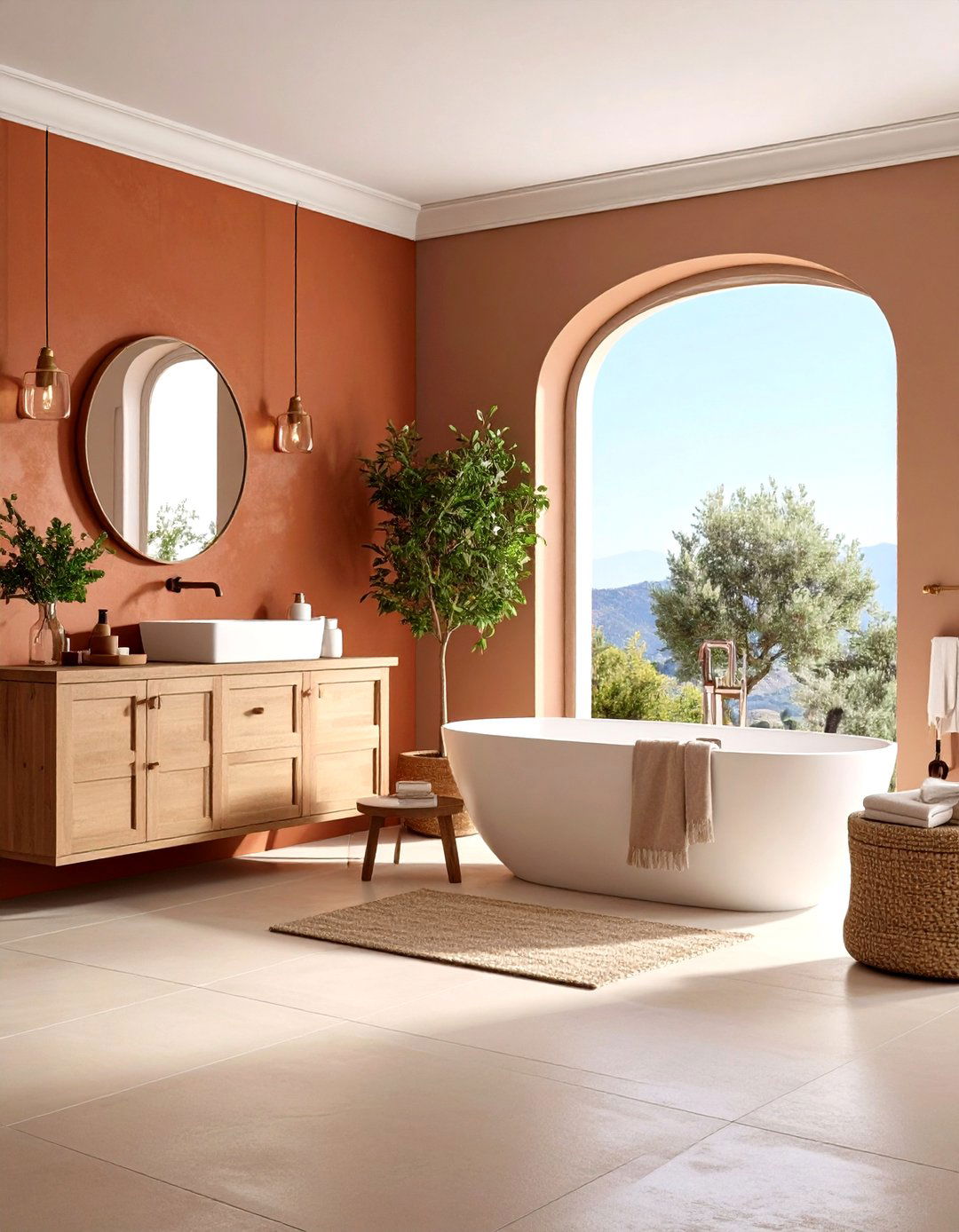
Warm earthy color palettes, featuring terracotta, warm beige, and deep brown hues, are at the heart of Tuscan bathroom design, evoking the sun-drenched landscapes of Italy. These shades can be applied to painted walls, tiles, and cabinetry to create a unified, inviting backdrop that feels both organic and timeless. Layering complementary tones—such as olive green or muted gold—brings depth and variation without overpowering the space. Accent walls in a richer terracotta provide a focal point, while softer neutrals maintain balance. By embracing this warm palette, you set a foundation that pairs beautifully with natural materials and handcrafted details throughout the room.
2. Natural Stone Flooring
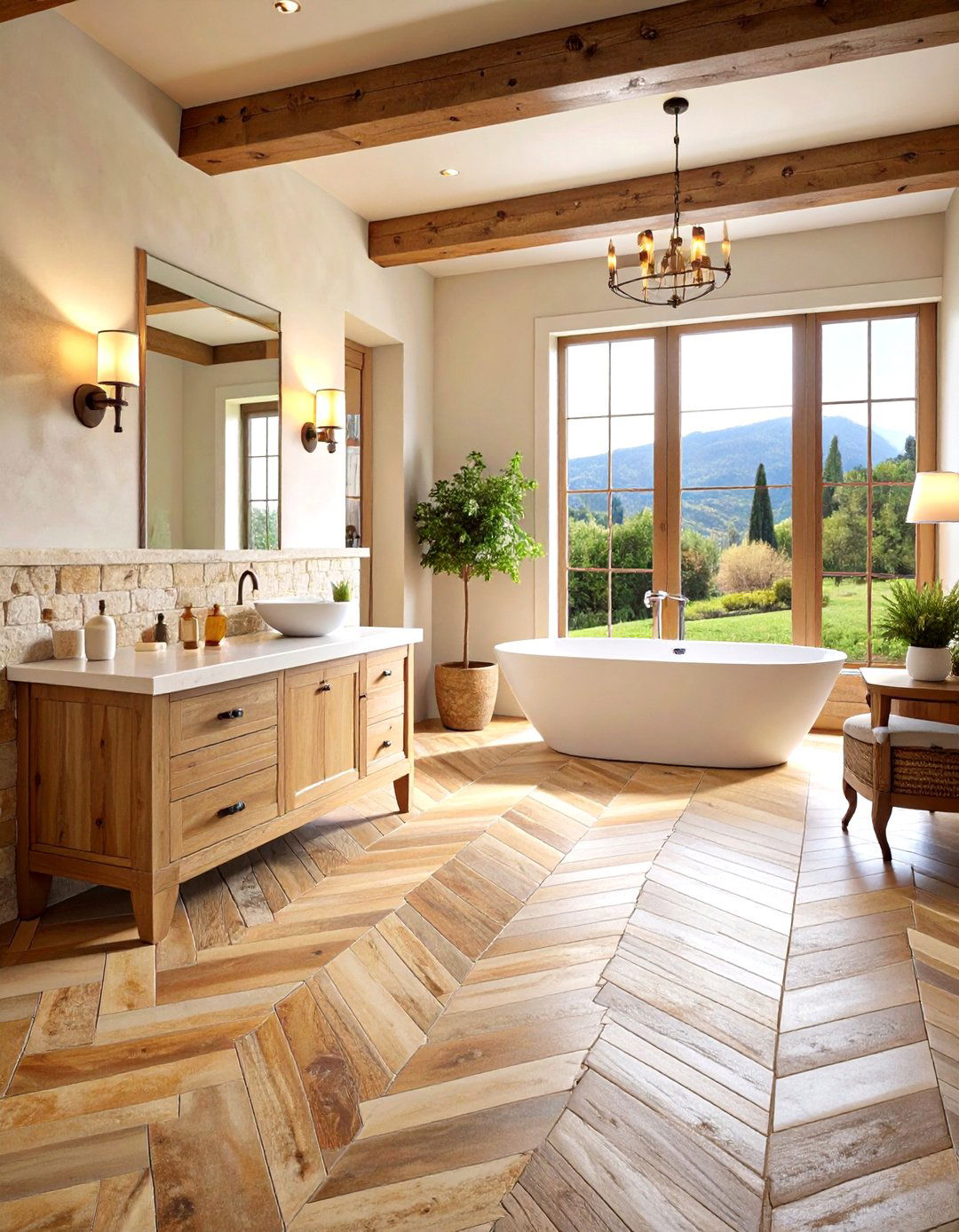
Natural stone flooring such as travertine, marble, or tumbled stone is a signature element in Tuscan bathrooms, lending a sense of authenticity and rustic elegance to the space. Its subtly varied tones and textures create visual interest underfoot while maintaining a cohesive, earthy aesthetic. These durable materials age gracefully, developing a patina that enhances the bathroom’s historic character over time. Installing the stone in a subtle herringbone or staggered pattern can add movement, while large-scale slabs emphasize simplicity. Sealing the surface preserves its natural beauty and ensures easy maintenance, making stone flooring both functional and timeless. Underfloor heating beneath the stone tiles further enhances comfort, especially in cooler months, marrying luxury with tradition.
3. Textured Wall Finishes
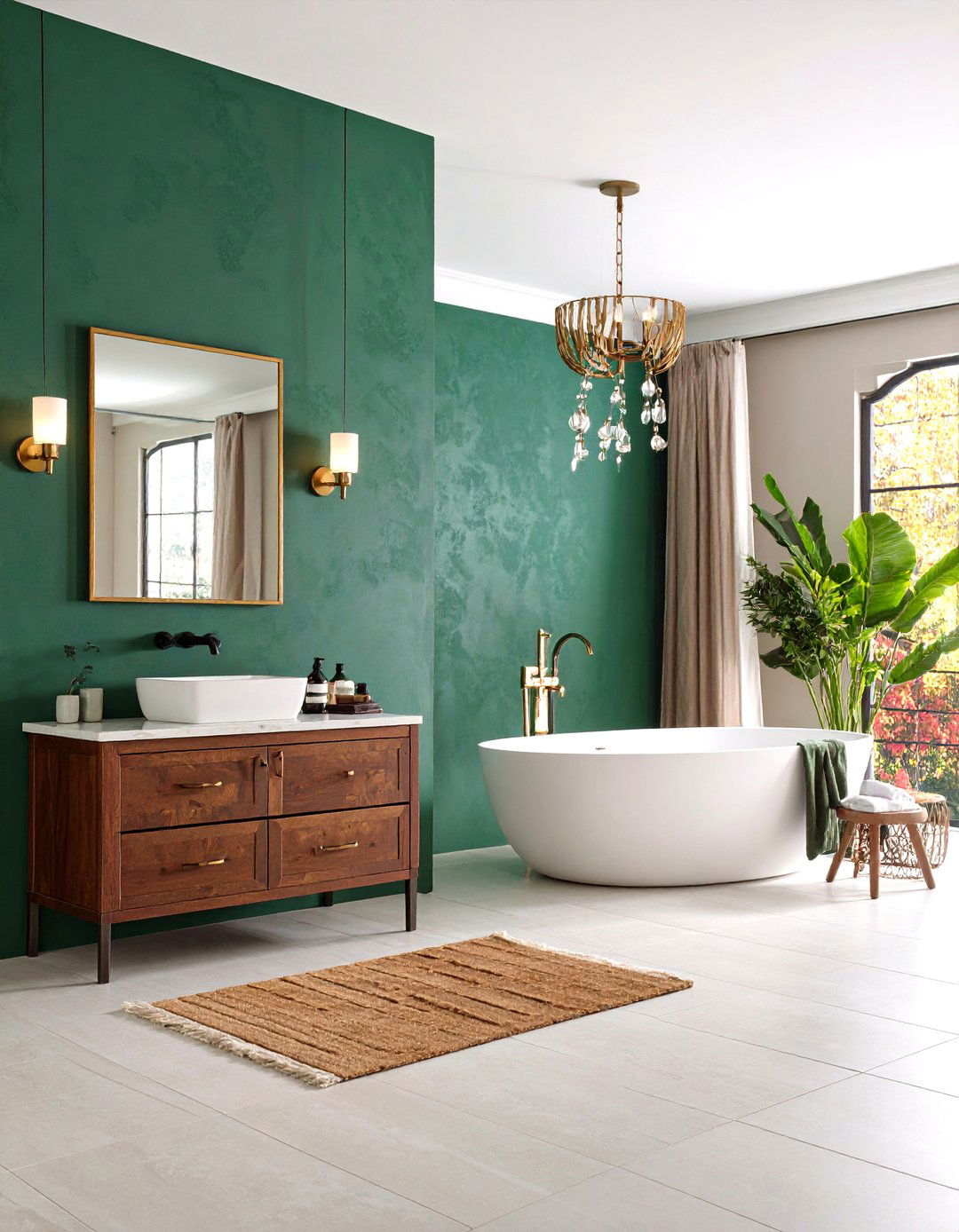
Textured wall finishes like Venetian plaster or faux stucco mimic the old-world plaster walls found in Tuscan villas, creating depth and warmth on every surface. These techniques involve layering and troweling pigment-infused plaster to produce subtle variations in color and texture that capture light beautifully. A soft matte finish complements polished stone and metal accents, preventing the room from feeling too clinical. For added interest, consider a two-tone effect blending a darker base coat with a lighter top layer. The result is an authentic, tactile backdrop that enhances all other design elements.
4. Rustic Wooden Vanities

Rustic wooden vanities crafted from reclaimed or distressed wood bring a tactile, organic quality to a Tuscan bathroom, marrying function with historical charm. These vanities often feature visible grain patterns, knots, and a weathered finish that speaks to age and craftsmanship. Pairing the cabinetry with a simple stone or marble countertop provides a refined counterpoint, while hand-wrought iron drawer pulls and faucets reinforce the artisanal aesthetic. To maintain the wood’s integrity, apply a protective sealant that guards against moisture without masking its natural beauty. Even small accents, like a vintage brass razor stand or a wrought-iron magazine rack, reinforce the timeless quality of the space.
5. Terra-cotta Tile Accents
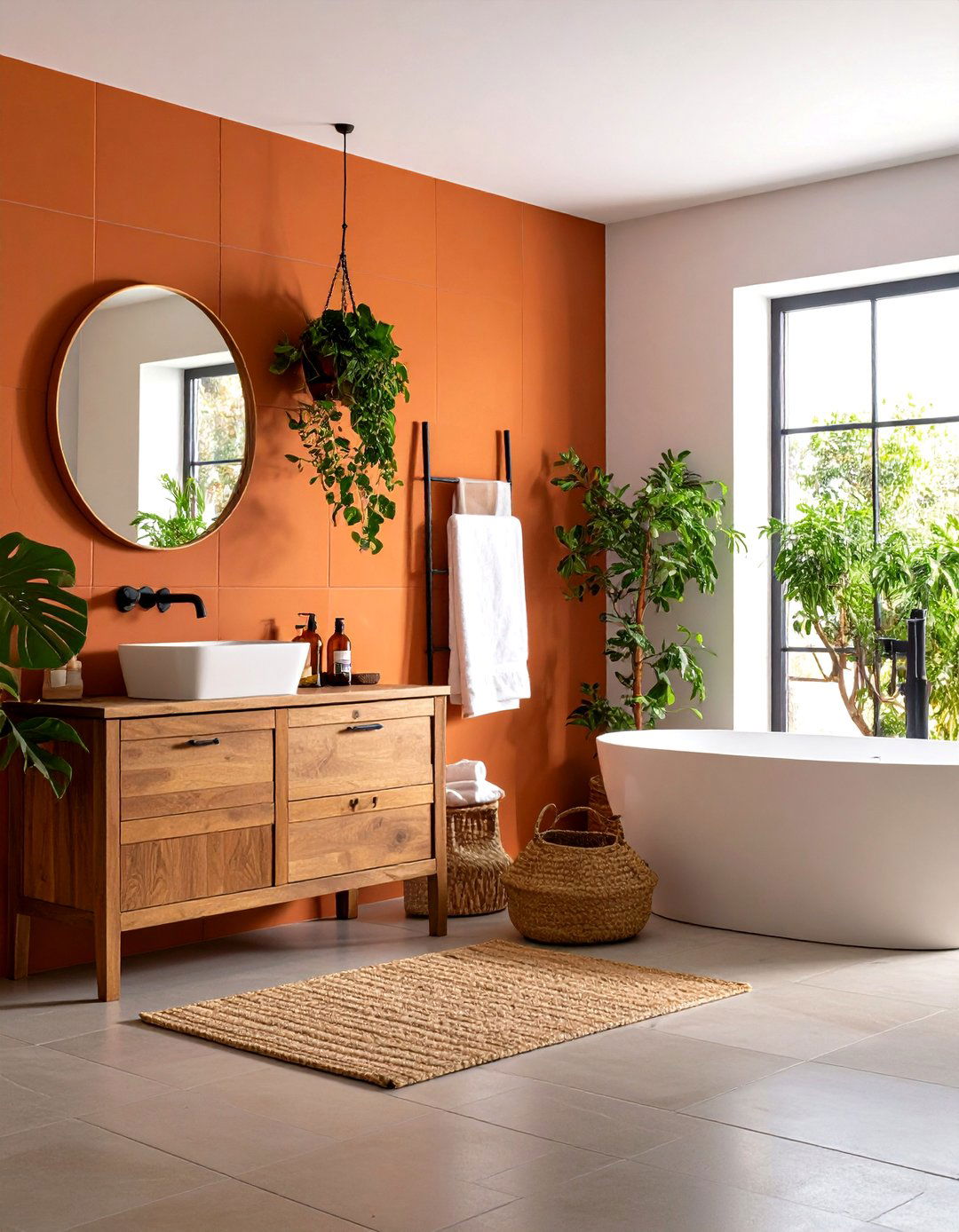
Terra-cotta tile accents infuse a Tuscan bathroom with Old World charm, recalling the sunbaked roofs and courtyards of rural Italy. Use flat, unglazed tiles on a feature wall or as a decorative border around mirrors and niches to introduce a warm, rustic texture. Alternately, patterned encaustic tiles in muted reds and ochres create a vibrant focal point on the floor or as backsplash. Sealing these porous tiles is essential to prevent staining, while dry brushing grout with a sand-colored hue helps maintain an authentic, timeworn look. When combined with natural stone and wood elements, terra-cotta tiles elevate the bathroom’s visual richness.
6. Exposed Wooden Ceiling Beams
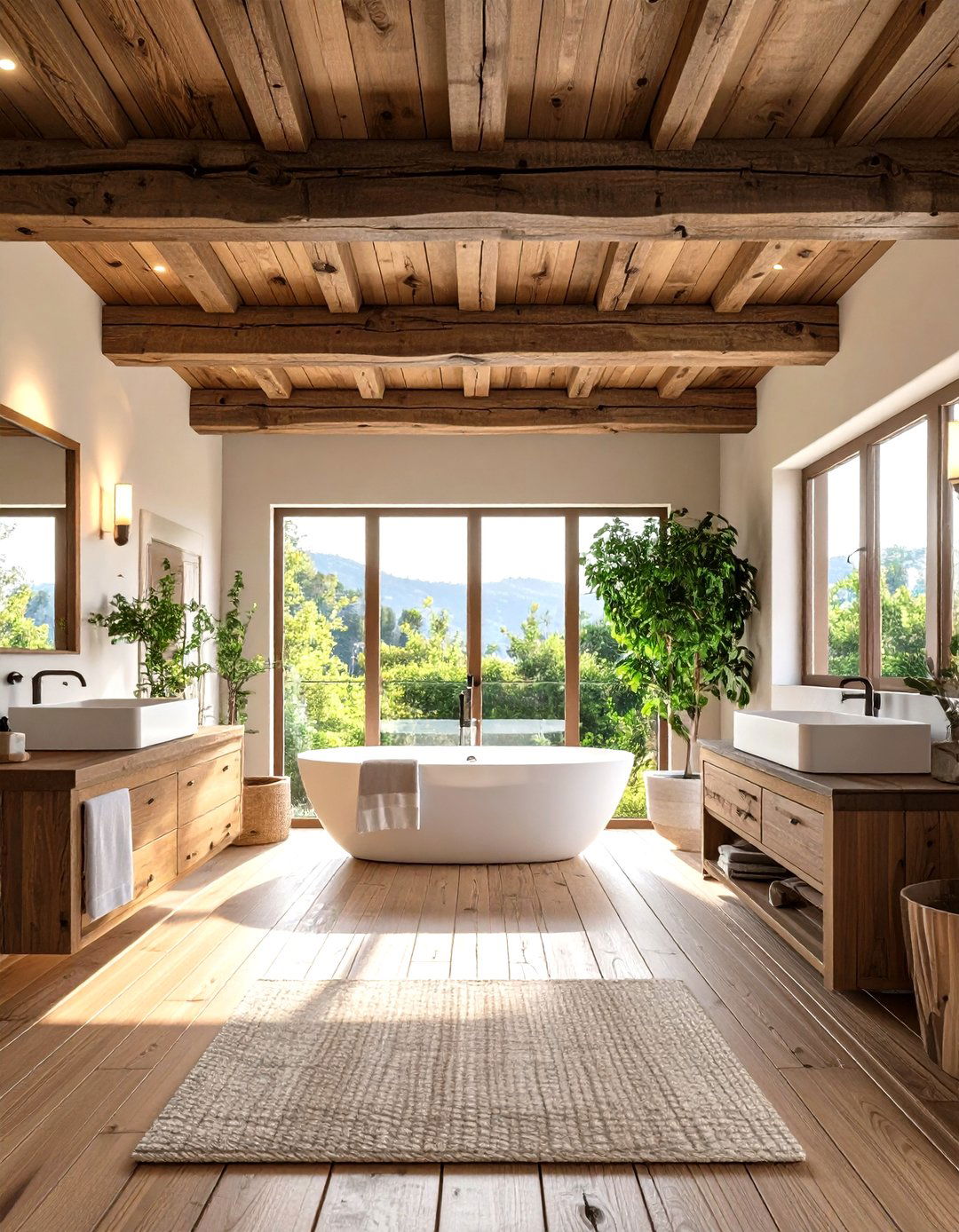
Exposed wooden ceiling beams add architectural interest and a rustic framework overhead, transforming a simple bath space into a Tuscan-inspired retreat. Whether using reclaimed oak or aged pine, these structural timbers introduce vertical warmth and a sense of history. Highlight the beams with soft uplighting or discreet recessed fixtures to accentuate their texture against smoother ceiling surfaces. For a lighter feel in smaller spaces, whitewash the beams to preserve their grain while brightening the room. This balance between heavy timber and airy finishes underscores the Tuscan commitment to combining solidity and light, crafting a tranquil yet grounded sanctuary.
7. Wrought Iron Fixtures
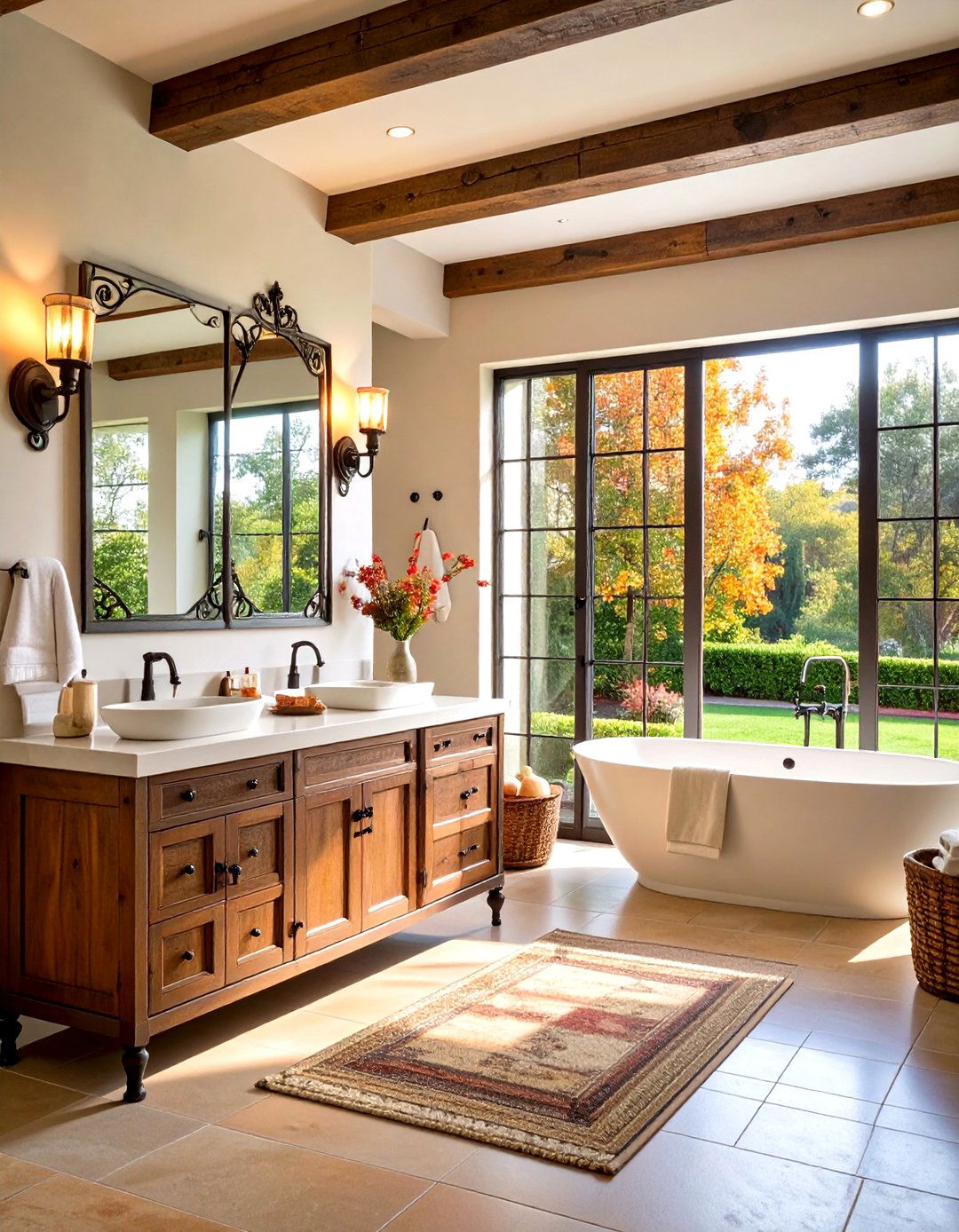
Wrought iron fixtures and hardware lend an artisanal edge to Tuscan bathrooms, echoing centuries of metalworking tradition. From faucet handles and towel racks to mirror frames and light sconces, hand-forged iron pieces introduce subtle patinas and intricate scrollwork. Opt for oil-rubbed bronze or aged iron finishes to complement warm color palettes and weathered textures. To avoid visual heaviness, balance darker metal accents with softer elements such as stone countertops or linen textiles. Well-crafted iron fixtures not only endure daily use but also serve as decorative focal points, reinforcing the historical authenticity that defines the Tuscan aesthetic.
8. Handcrafted Ceramic Sinks
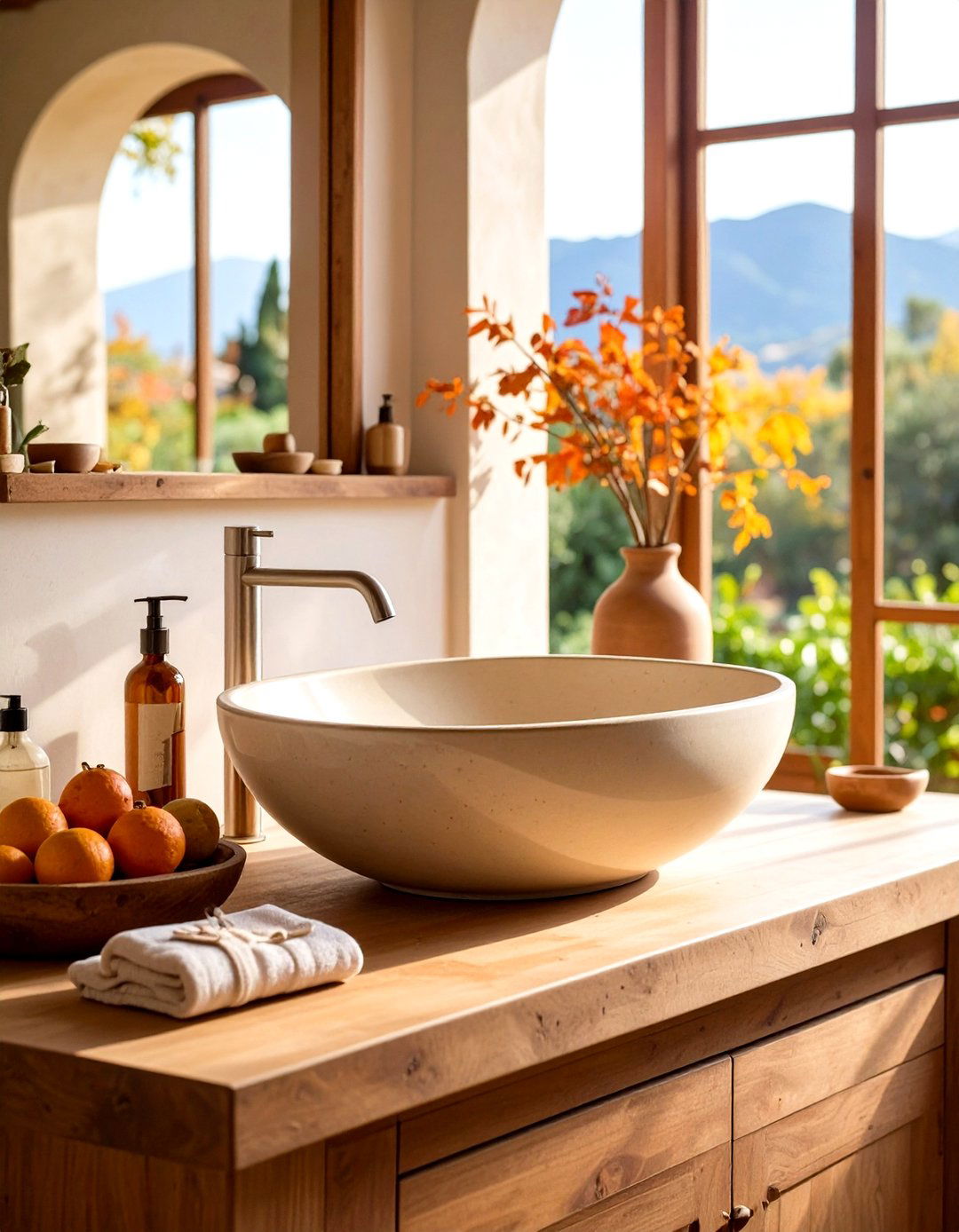
Handcrafted ceramic sinks bring a bespoke quality to Tuscan-inspired bathrooms, showcasing artisanal craftsmanship through unique shapes and glazes. Whether hand-painted with Mediterranean motifs or molded into organic forms, these sinks serve as both functional fixtures and sculptural elements. Vessel bowls in earthy tones of cream, terracotta, or indigo command attention atop natural stone or wood vanities. Match with simple, complementing hardware to let the sink’s artisan details shine. Regular cleaning with gentle, non-abrasive cleaners preserves glaze finishes, ensuring the vessel retains its vibrant character. A handcrafted ceramic sink transforms a routine ritual into a daily aesthetic pleasure.
9. Arched Doorways and Niches
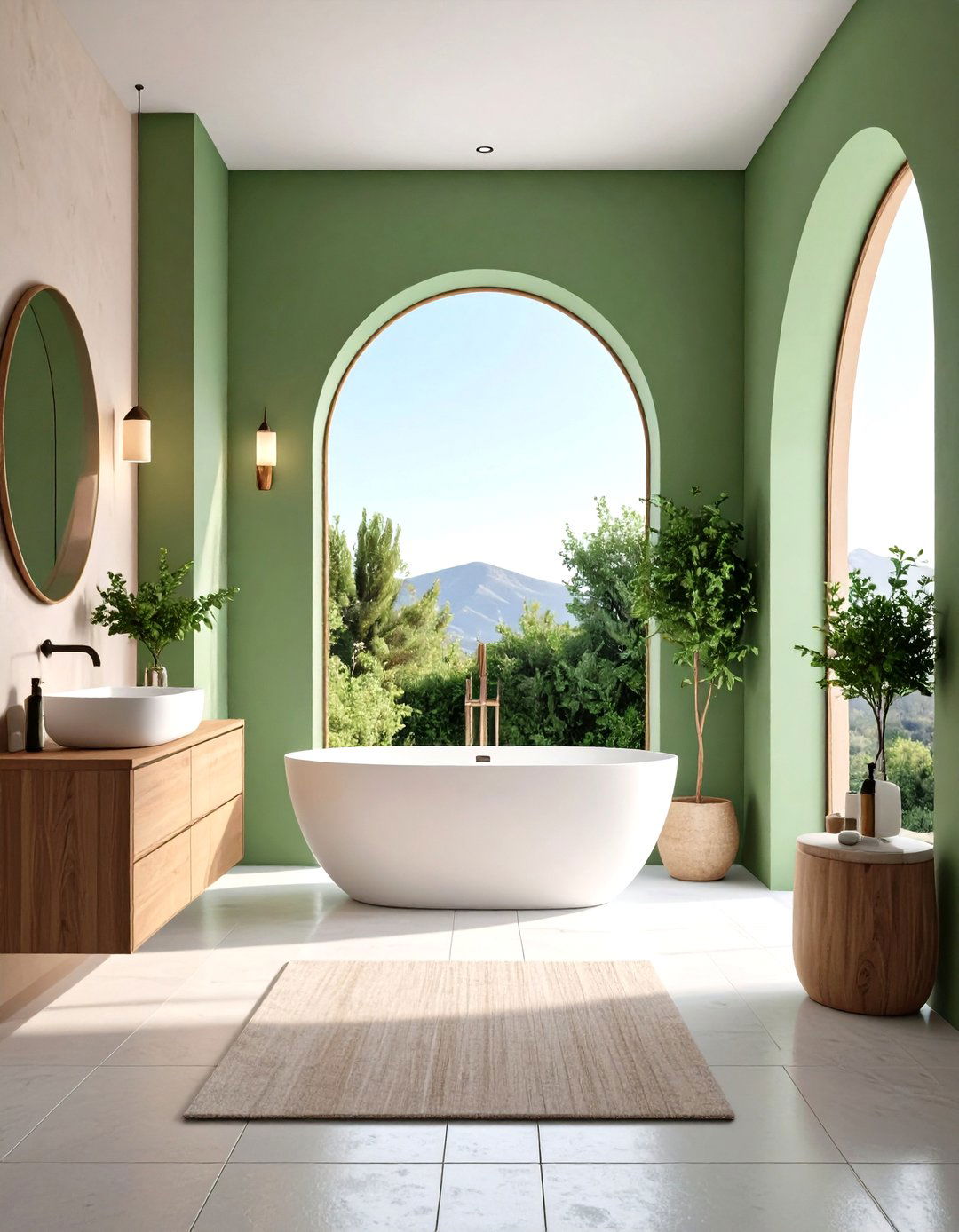
Arched doorways and recessed niches introduce elegant architectural curves that define Tuscan bathroom spaces, recalling the arches of Italian villas. Smooth, rounded openings over showers, alcoves, or cabinetry soften geometric layouts and create inviting focal points. Niches beneath arches can house candles, ceramics, or greenery, lending both function and decoration. To accentuate the curves, apply a slightly contrasting plaster finish or border tile that highlights the arch’s silhouette. These gentle arcs break monotony, guiding the eye upward and imparting a sense of historical gravitas. Incorporating arches adds a timeless elegance that is instantly recognizable as classic Tuscan style.
10. Statement Chandeliers and Lighting
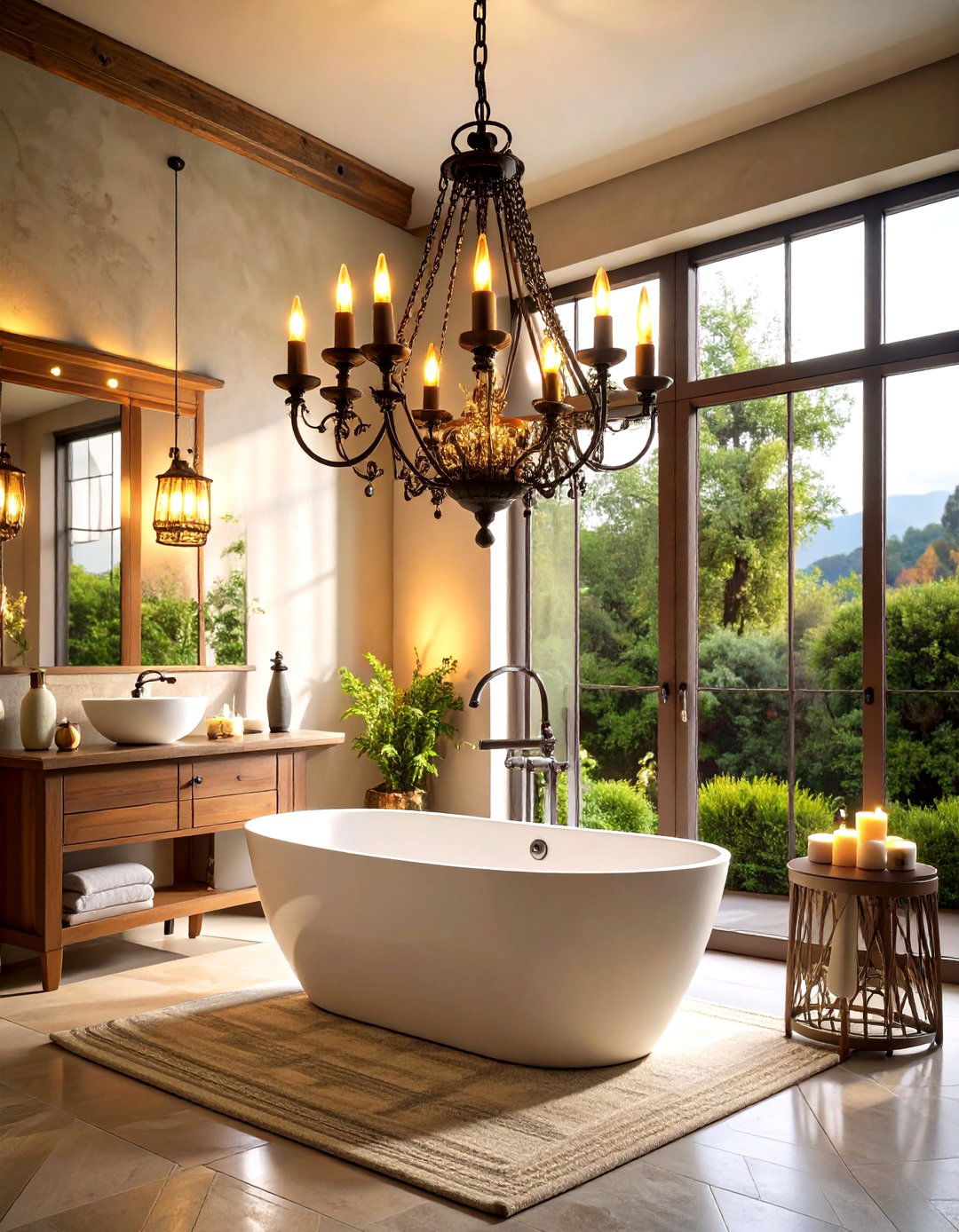
Statement chandeliers and lantern-style lighting fixtures elevate the elegance of Tuscan bathrooms, blending rustic form with refined function. Choose wrought-iron chandeliers with candle-inspired bulbs or lantern pendants in aged bronze to cast a warm, ambient glow. Complement overhead fixtures with wall sconces flanking mirrors, ensuring layered illumination that enhances both practicality and mood. Incorporate dimmer switches to adjust light levels for relaxing baths or invigorating morning routines. For moisture-prone zones, select damp-rated fixtures designed to withstand humidity. By combining bold shapes and artisanal finishes, strategic lighting transforms a utilitarian space into a sumptuous sanctuary.
11. Freestanding Soaking Tub
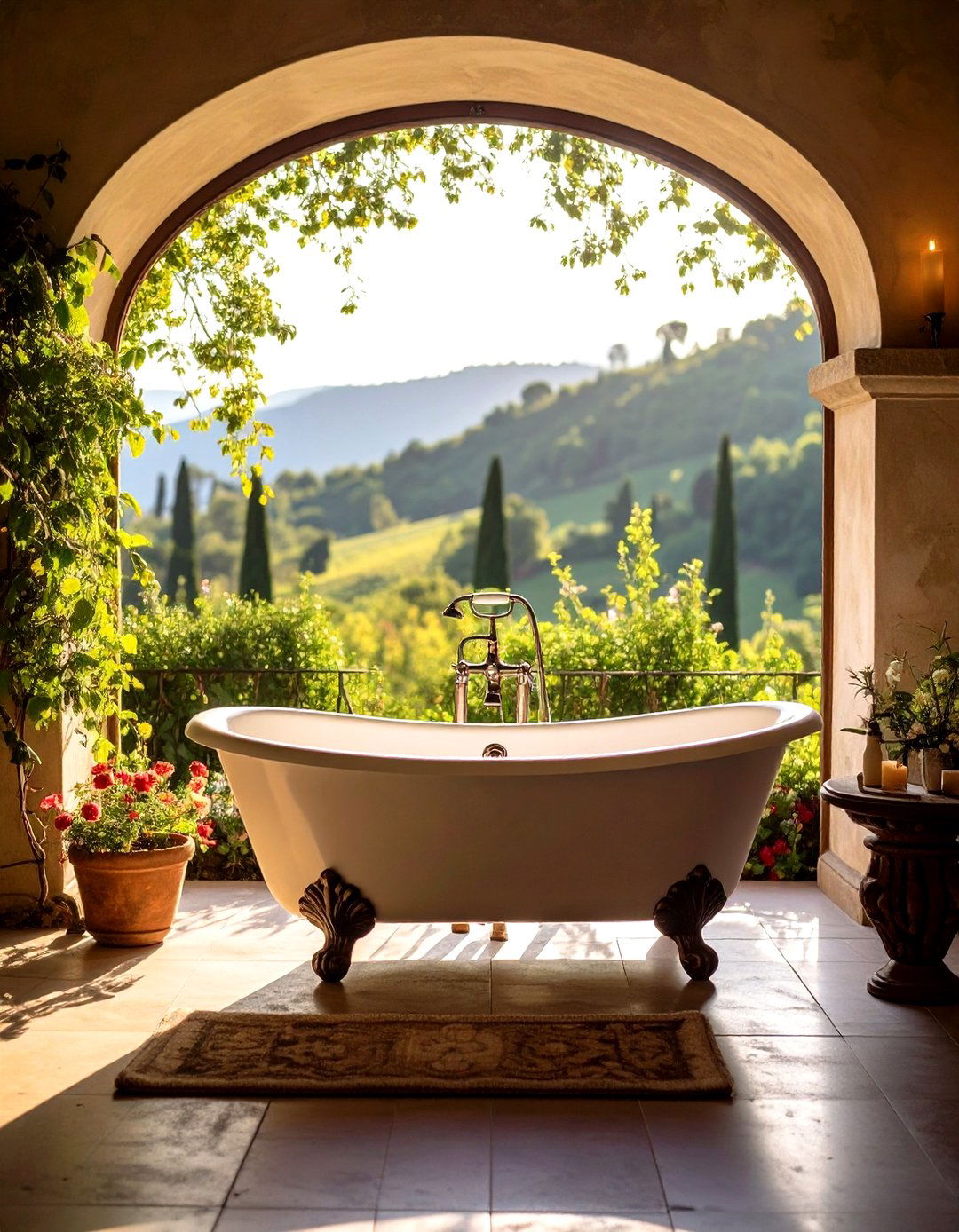
A freestanding soaking tub, particularly in classic clawfoot or simple stone forms, becomes the centerpiece of a Tuscan-inspired bathroom oasis. Placed beneath arched windows or alongside textured plaster walls, the tub invites indulgent relaxation. Opt for a sculptural silhouette in cast iron or stone resin, finished in matte white or natural stone hues that complement surrounding finishes. Surround the tub with decorative pedestals holding candles or plants for an intimate, spa-like ambiance. Ensure ample floor space to highlight its form, and pair with a floor-mounted tub filler in a warm metallic finish. The result is a dramatic focal point that echoes Old World luxury.
12. Stone and Marble Countertops
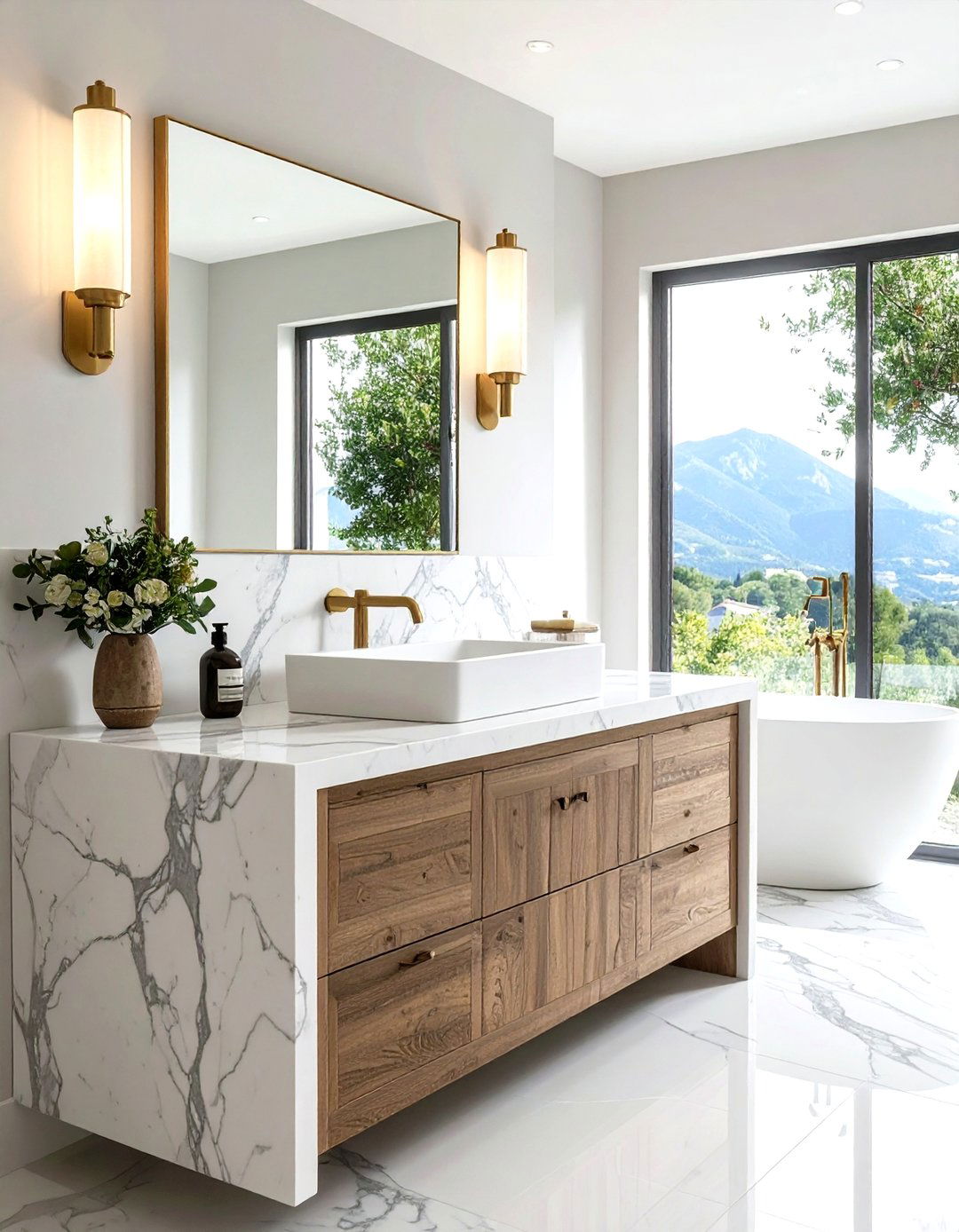
Stone and marble countertops introduce luxurious veining and natural patterns to Tuscan bathroom vanities, offering durability alongside visual richness. Classic Italian marble such as Carrara or Calacatta adds crisp white backgrounds interlaced with grey veining, while local limestone and travertine bring warmer beige tones. A honed or matte polish underscores a more subdued, rustic feel, whereas a polished surface enhances reflective properties. Seamless integration of sink basins into stone slabs creates a cohesive, monolithic look. Maintain countertops with gentle, pH-neutral cleaners and periodic sealing to preserve their luster and prevent etching, ensuring long-lasting elegance.
13. Artisan Tile Murals
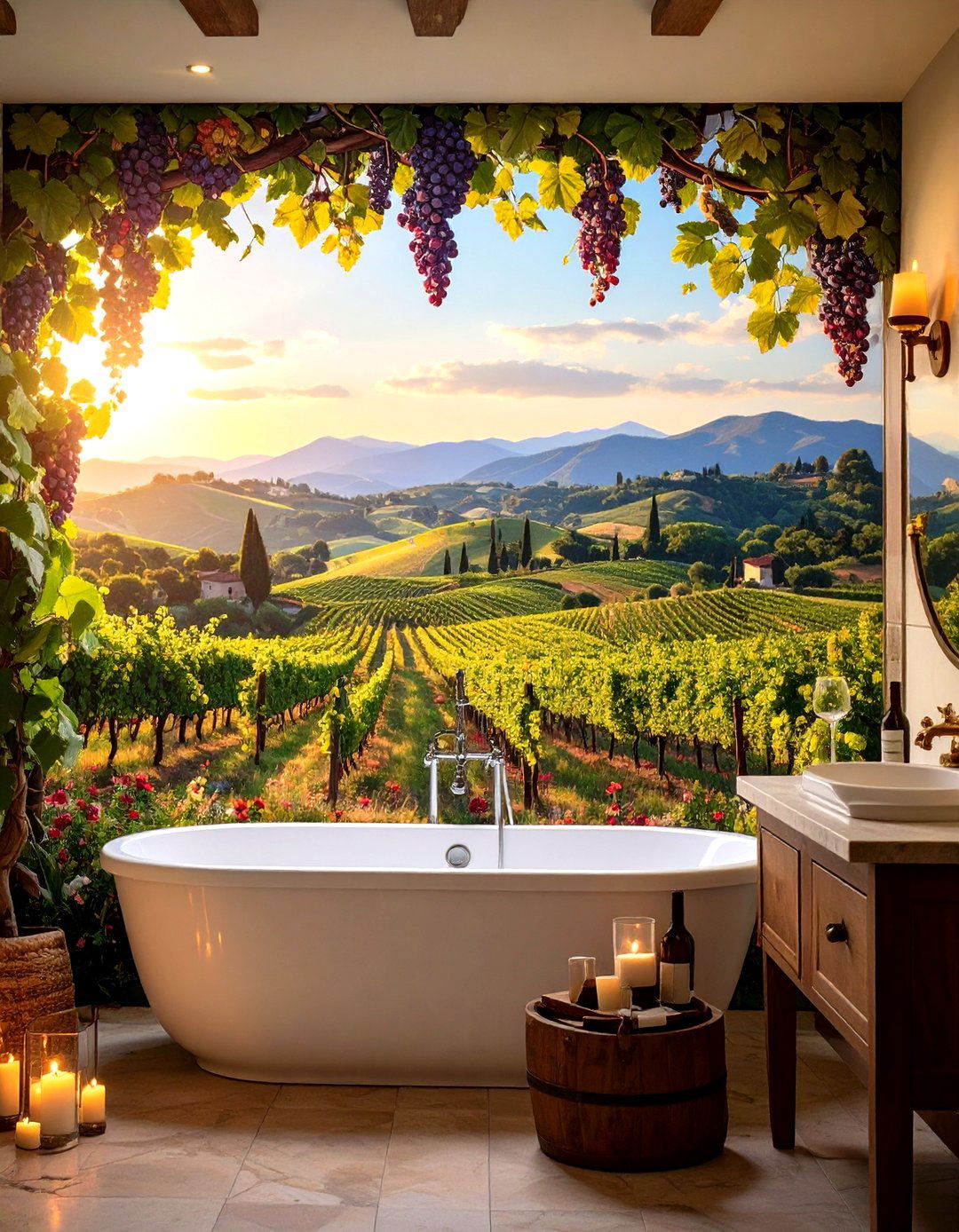
Artisan tile murals infuse Tuscan bathrooms with vibrant storytelling scenes, depicting pastoral landscapes, grapevines, or classic medallions that celebrate Italian heritage. Crafted by skilled ceramicists, these hand-painted tiles can serve as dramatic shower backdrops or feature walls behind vanities. To let the mural shine, surround it with neutral-textured tiles or smooth plaster finishes. Grout hues matching the dominant palette unify the mural with its setting. Protective sealing ensures the artwork remains vivid and resists moisture. For smaller budgets, mosaic inserts featuring geometric motifs offer a nod to Tuscan tradition without creating a full-scale mural.
14. Antique Mirrors and Frames
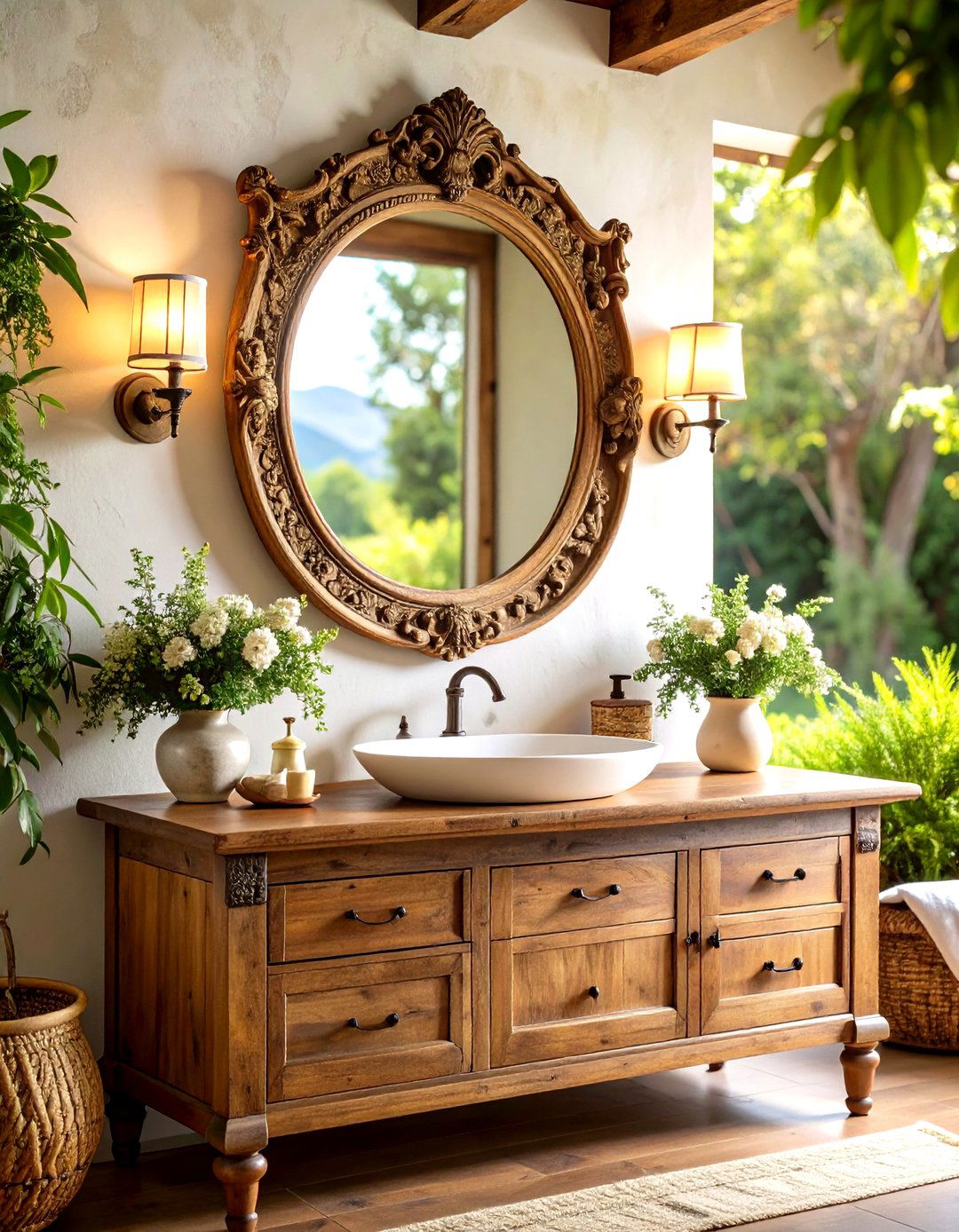
Antique mirrors with ornate frames lend a sense of history and elegance to Tuscan bathroom interiors, reflecting light and enhancing the perception of space. Seek out distressed wood or metal frames featuring carved scrollwork, rope motifs, or patinated finishes. Placing the mirror above a rustic vanity not only provides essential function but also anchors decorative vignettes of ceramics and candles. For a more dramatic effect, consider floor-length mirrors leaning against textured walls. Careful restoration—like re-glazing or gentle cleaning—preserves the antique’s character while ensuring safe use in moisture-prone areas. A well-selected vintage mirror becomes both art and utility.
15. Built-in Alcove Shelving
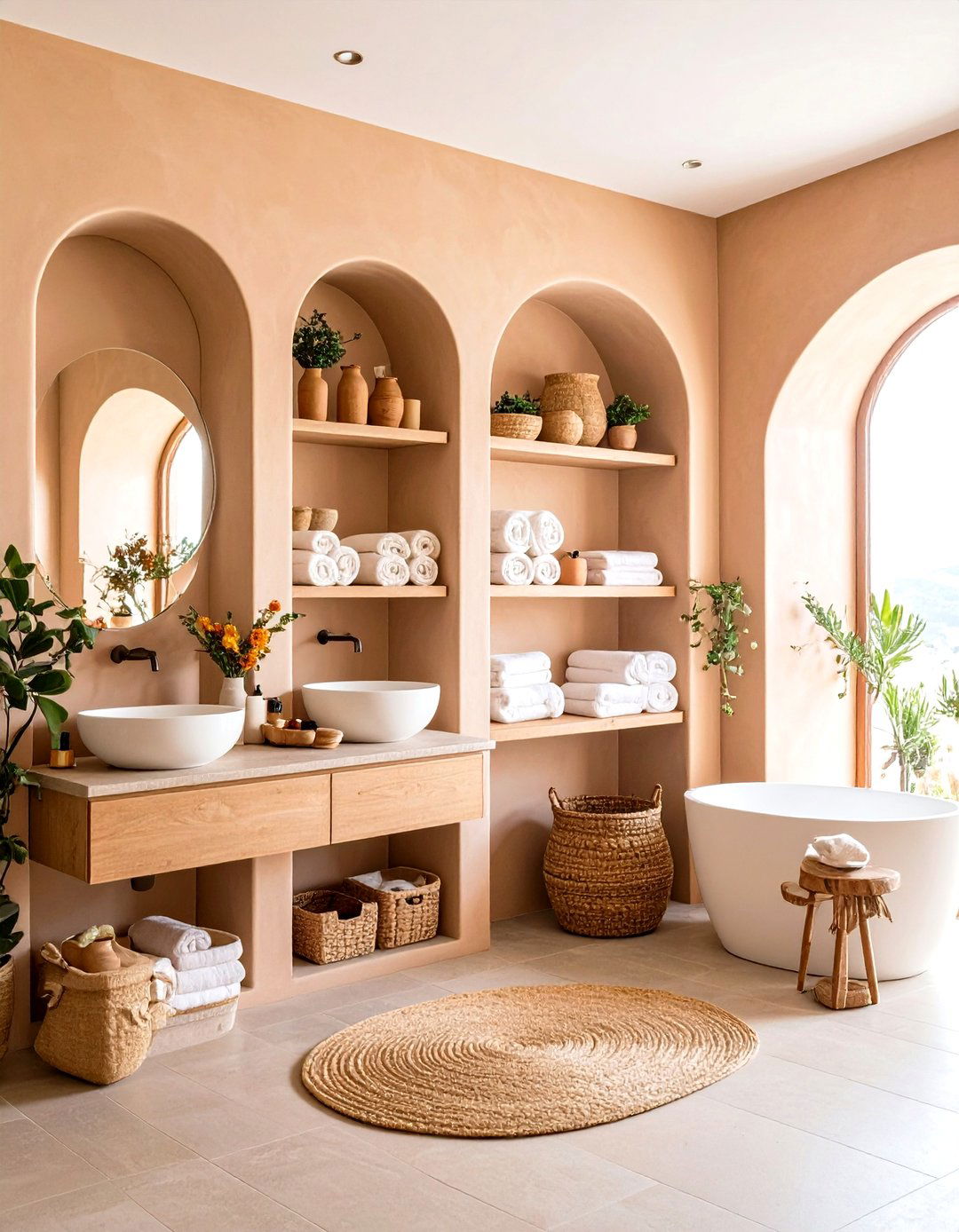
Built-in alcove shelving carved into plaster walls provides practical storage while maintaining a seamless, handcrafted aesthetic in Tuscan bathrooms. These recessed niches can display rolled linens, pottery, or iron baskets, maximizing space without bulky furniture. Rounded or arched tops echo other architectural curves, delivering cohesion throughout the room. Finish the interior of each shelf with smooth Venetian plaster or contrasting tile to highlight its depth. Integrated lighting strips reveal displayed items and add warmth. By building storage into the structure, you achieve a clean, uncluttered appearance that honors Tuscan design’s emphasis on both functionality and artistry.
16. Vintage Hardware and Accessories
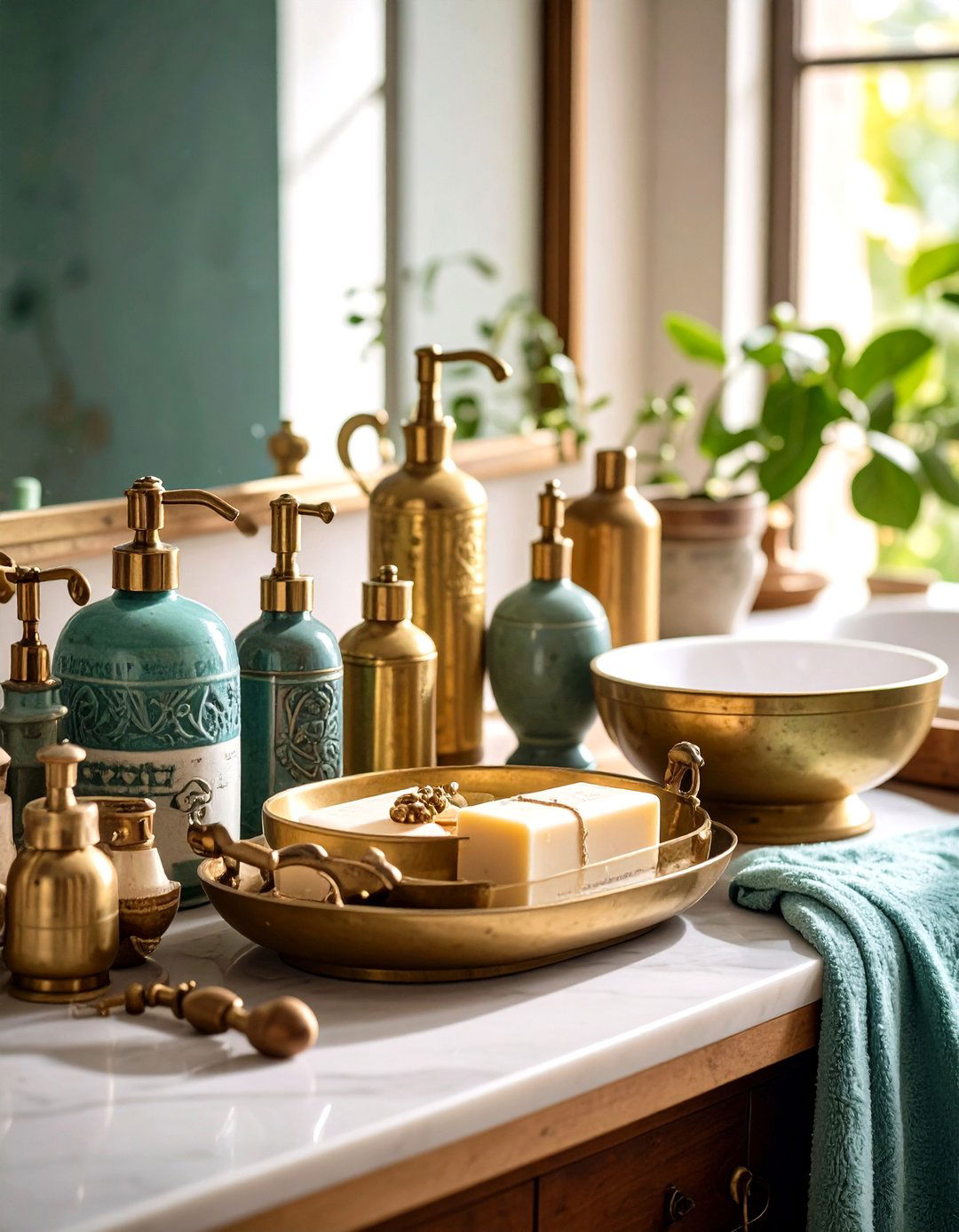
Vintage hardware and accessories, such as brass soap dishes, wrought-iron towel hooks, and aged bronze bath caddies, add authentic character to Tuscan bathrooms. Scouring flea markets or antique stores for repurposed items allows you to curate unique decor that tells a story. Integrate antique ceramic soap dispensers, handwoven baskets, and decorative jars to organize essentials while enhancing the rustic ambiance. Combining vintage pieces with new fixtures creates a layered, collected look that feels both lived-in and refined. Ensure all metal finishes are sealed to resist moisture, preserving their patina and guaranteeing lasting functionality.
17. Potted Greenery and Terracotta Planters
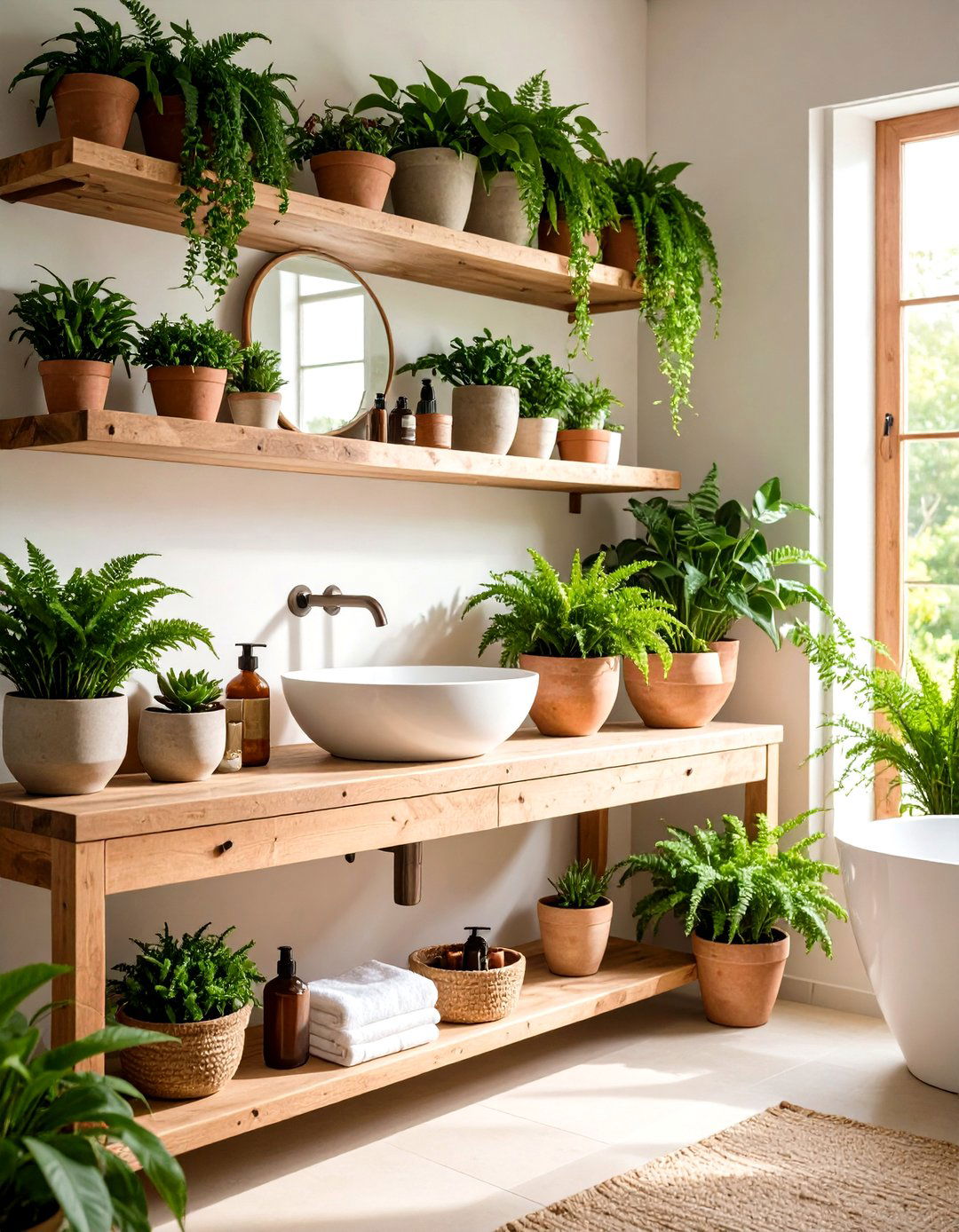
Potted greenery in terracotta planters breathes life into a Tuscan bathroom, connecting the interior to the region’s verdant landscapes. Select humidity-loving species such as ferns, aloe, and ivy that thrive in warm, moisture-rich environments. Simple clay pots with weathered surfaces echo traditional Italian planters, while varying heights and diameters create visual rhythm. Place taller plants in empty corners, and arrange smaller pots on built-in shelves or window sills for a spa-like ambiance. The natural greenery softens hard finishes and introduces fresh color, completing the organic, immersive experience of a Tuscan retreat.
18. Warm Metallic Finishes
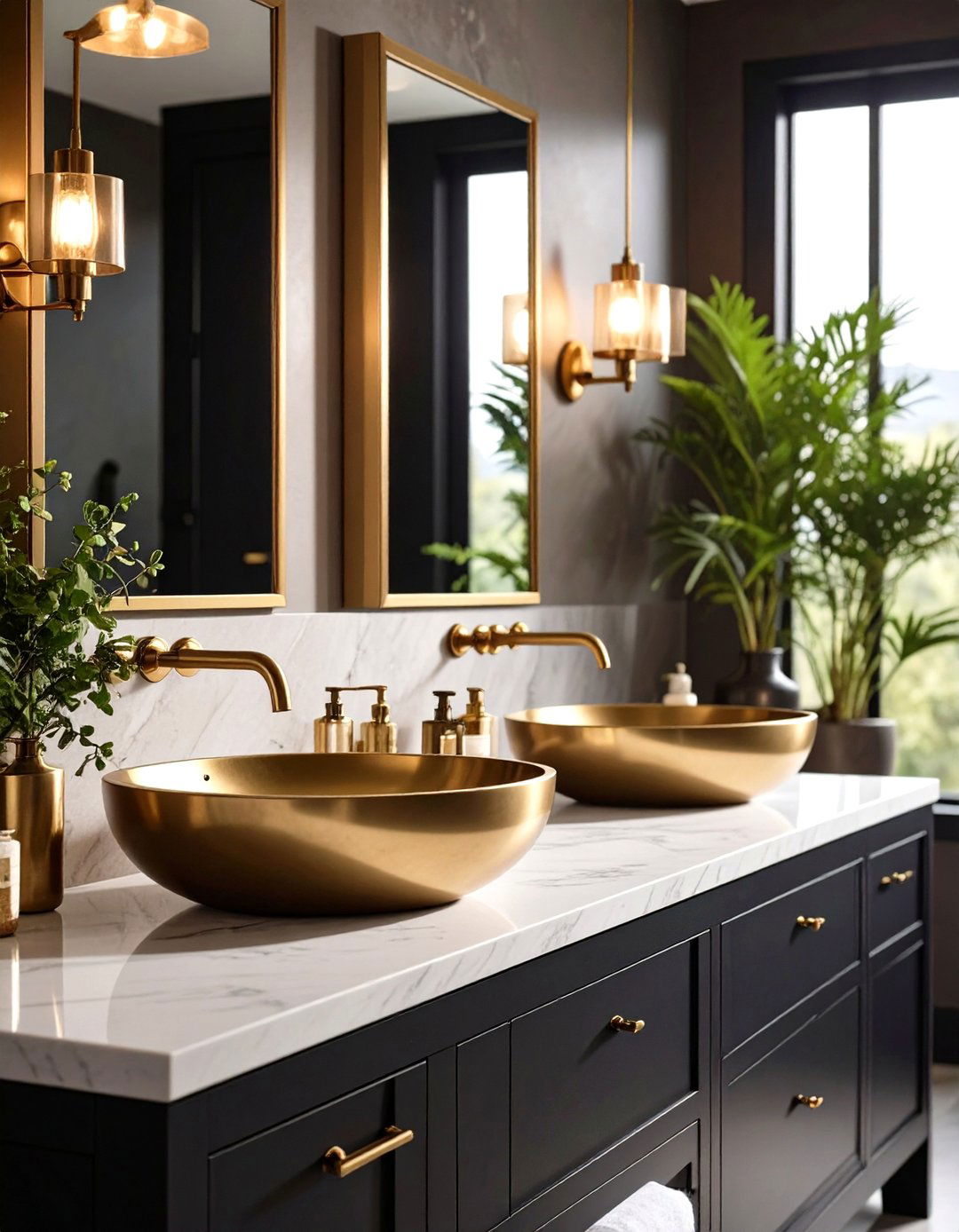
Warm metallic finishes such as brushed bronze, aged gold, and matte black convey understated luxury in Tuscan bathrooms, harmonizing with earthy textures and tones. Use these metals for faucets, shower hardware, light fixtures, and mirror frames to introduce subtle gleam without overpowering the rustic aesthetic. Matte finishes scatter reflections for a softer look, while polished accents provide focal highlights. Coordinating fixtures with small accessories—like soap pumps, towel bars, and decorative hardware—reinforces a cohesive design. The contrast between the metallic gleam and rugged natural materials underscores the balance between sophistication and authenticity central to Tuscan style.
19. Soft Linens and Fabrics
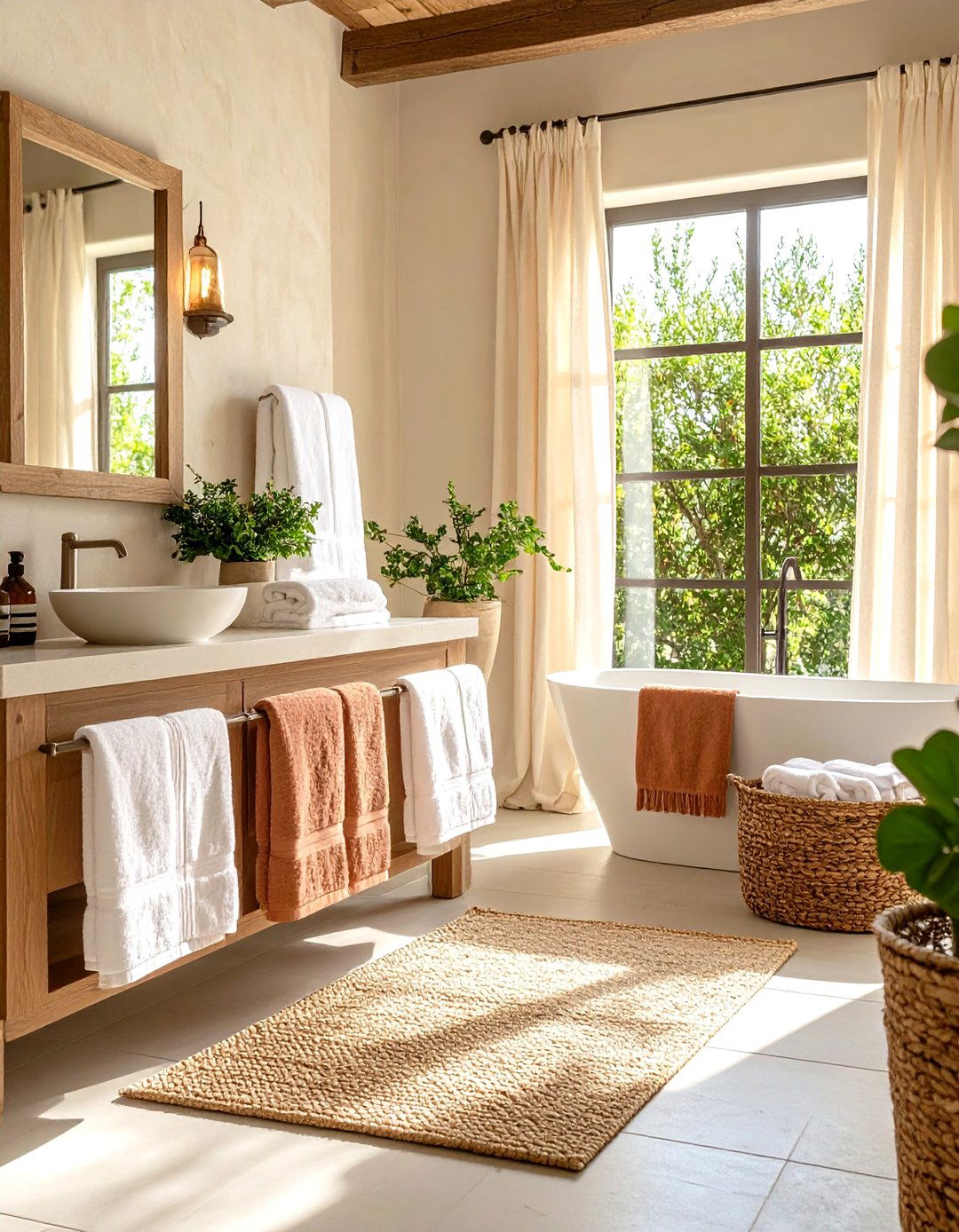
Soft linens and fabrics in natural fibers elevate comfort and warmth within a Tuscan bathroom, echoing the region’s relaxed lifestyle. Choose plush, cotton or pure linen towels in muted hues—terracotta, olive, or cream—that harmonize with the surrounding palette. Handwoven bath mats or rugs made from jute or wool provide texture and absorbency underfoot. Incorporate linen shower curtains, textured window treatments, or hand-crafted textiles draped over benches to add softness. Organic fabrics not only feel inviting but also age gracefully, acquiring subtle imperfections that enhance their charm. Layered textiles transform a functional space into a cozy, sensory haven.
20. Decorative Artwork and Accessories
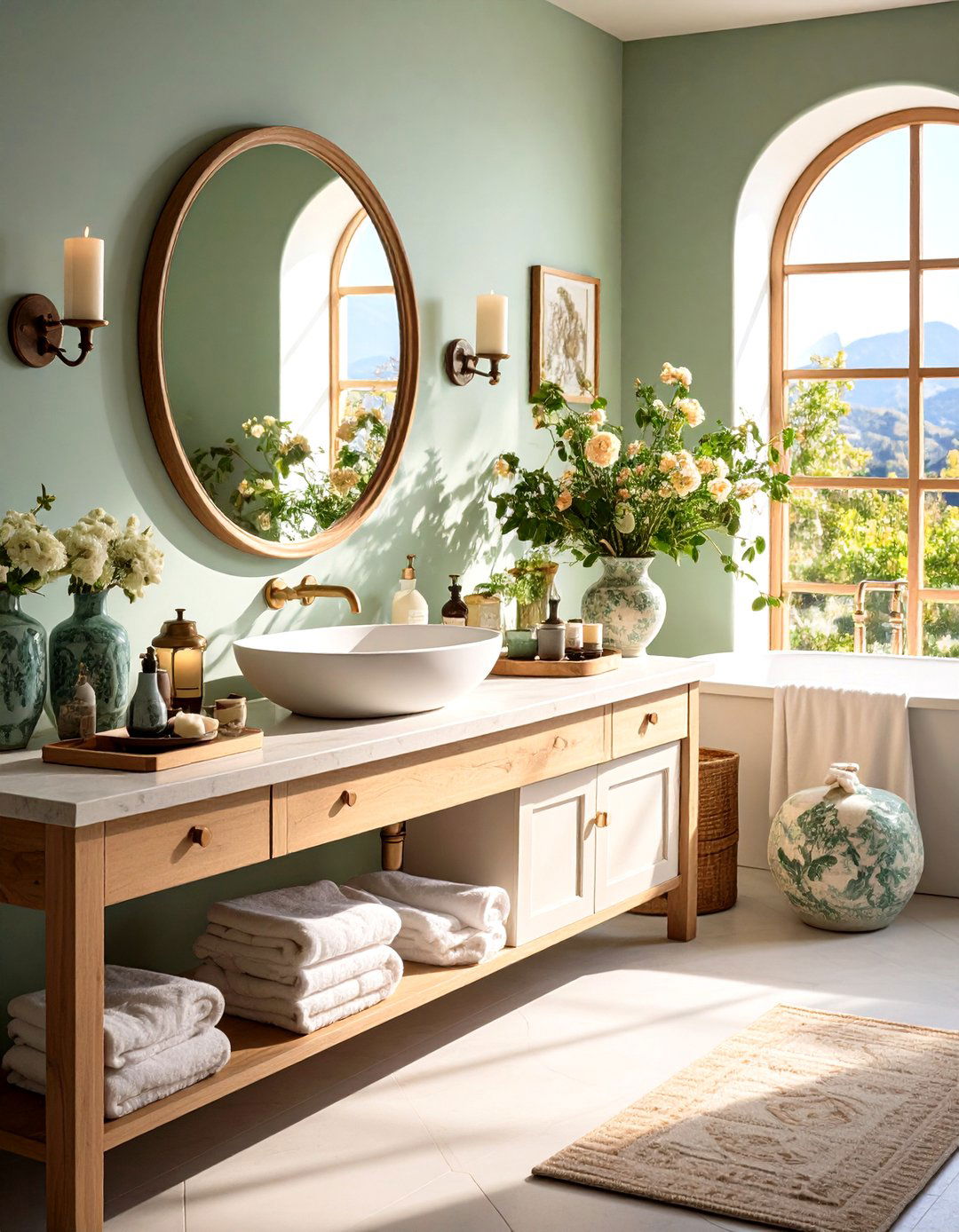
Decorative artwork and accessories complete the Tuscan bathroom narrative, infusing personal style and finishing touches that reflect Old World charm. Handcrafted pottery, ceramic vases adorned with Italian motifs, or framed botanical prints bring curated visual interest to walls and shelves. Small sculptures or antique candlesticks on countertops enhance the vignette without clutter. Fresco-inspired wall panels or patterned textiles folded and displayed behind glass accentuate cultural references. By thoughtfully layering art and accessories, you create a cohesive environment where each piece contributes to the overall warmth, artistry, and historic resonance typified by authentic Tuscan design.
Conclusion:
Incorporating Tuscan-inspired elements into a bathroom transcends mere decoration; it creates a sensory retreat steeped in the warmth, history, and craftsmanship of the Italian countryside. Through warm earthy palettes, natural stone and wood materials, hand-forged metalwork, and artisanal tiling, each design choice layers texture and narrative. Architectural details such as arches, exposed beams, and built-in niches unify function with elegance, while statement fixtures and vintage accents anchor the space. The addition of lush greenery, soft linens, and curated accessories completes the immersive experience, ensuring a harmonious balance between authenticity and modern comfort. Whether undertaking a full remodel or refining a single accent, these twenty Tuscan bathroom ideas offer timeless inspiration to transform any bath into an inviting villa-like sanctuary. Embrace the heritage and warmth of Tuscan design to craft a space that invites relaxation and timeless beauty.


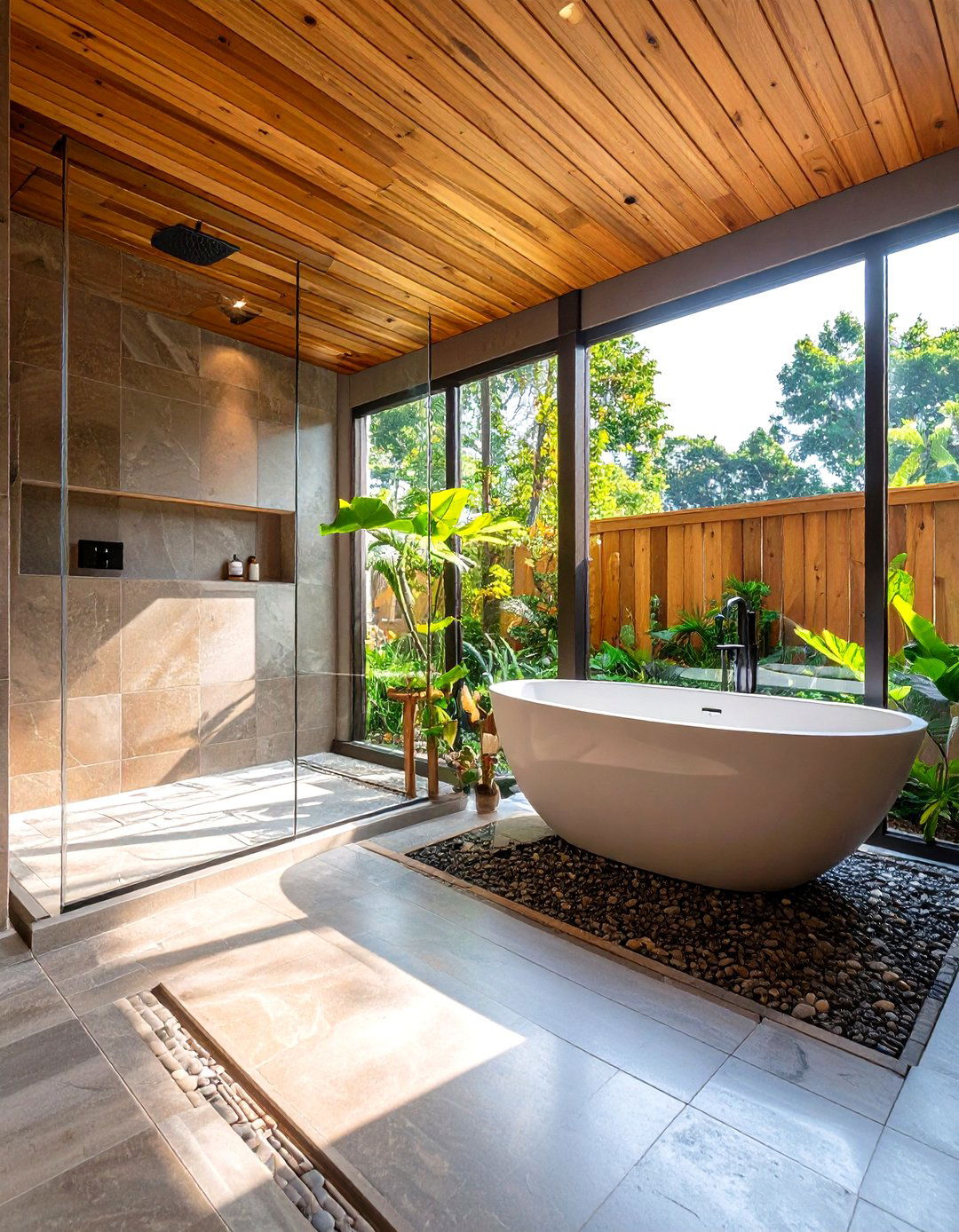
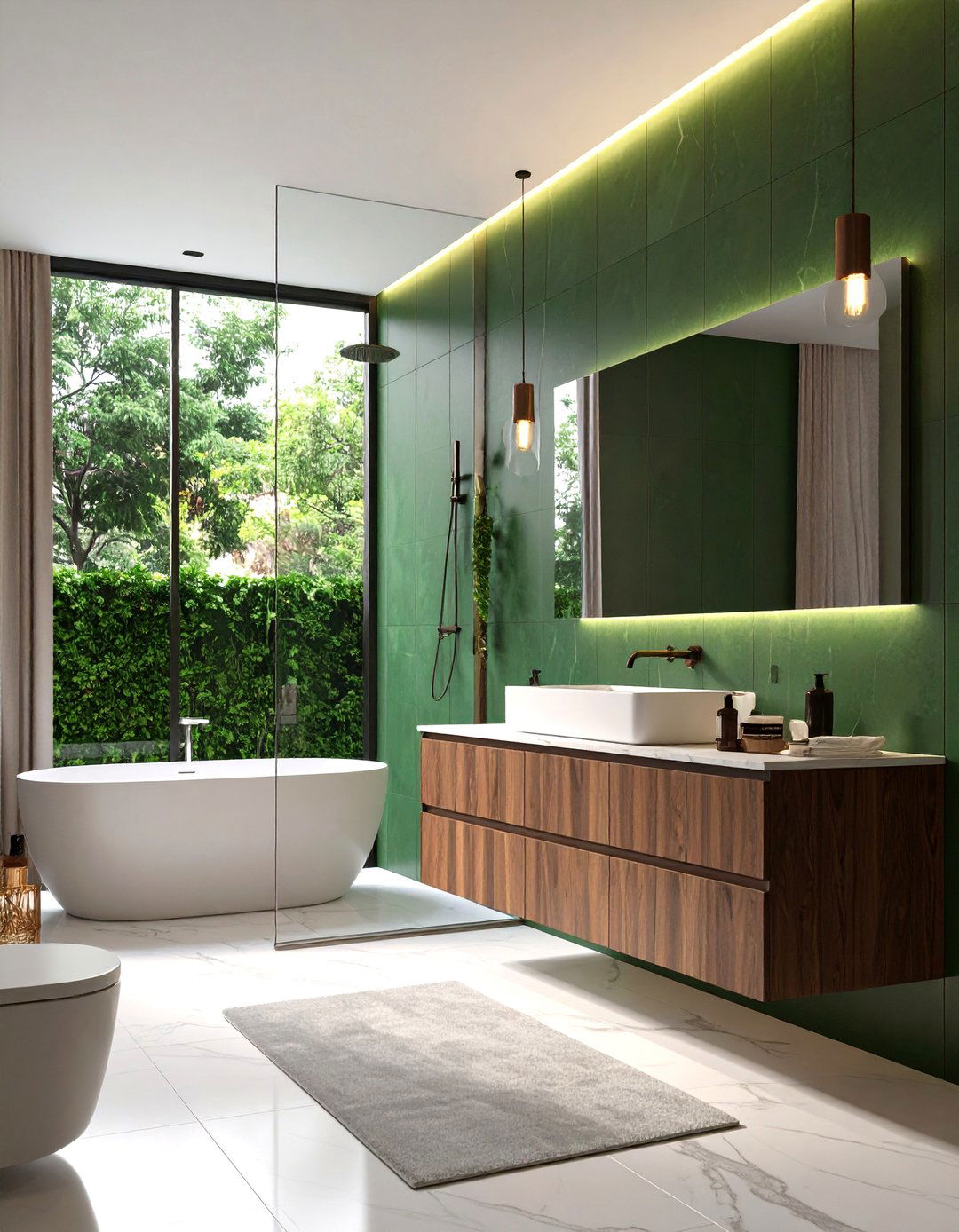
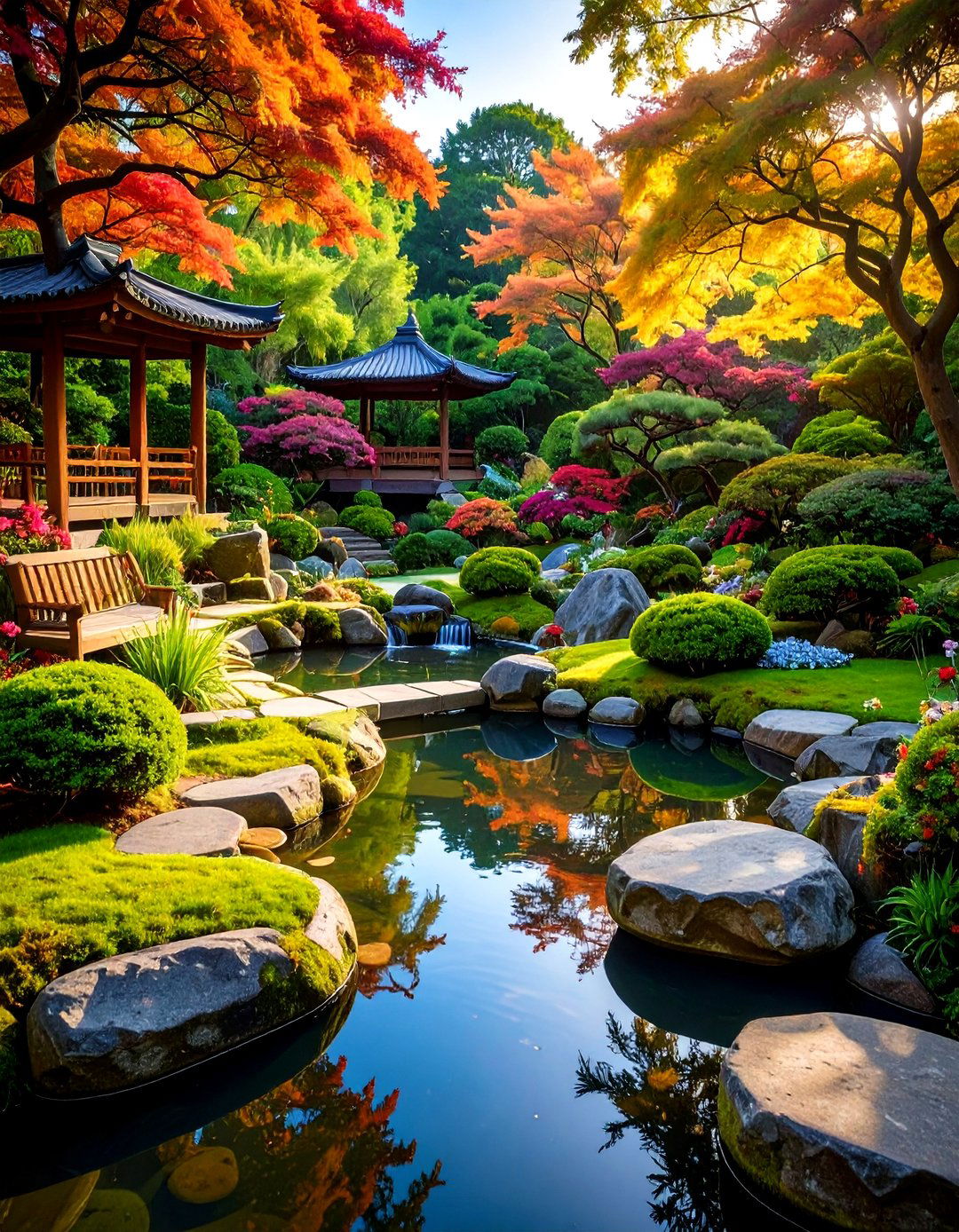
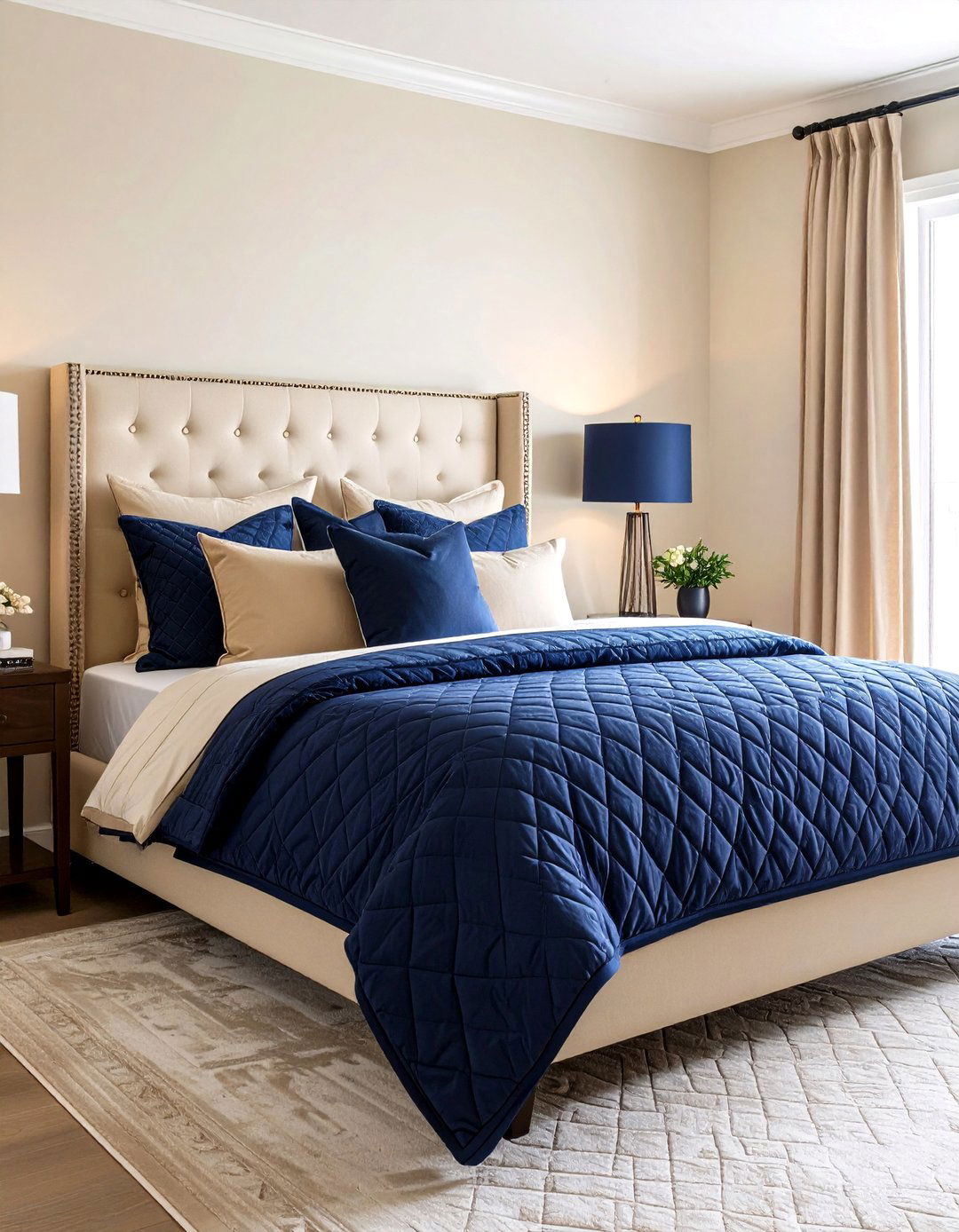
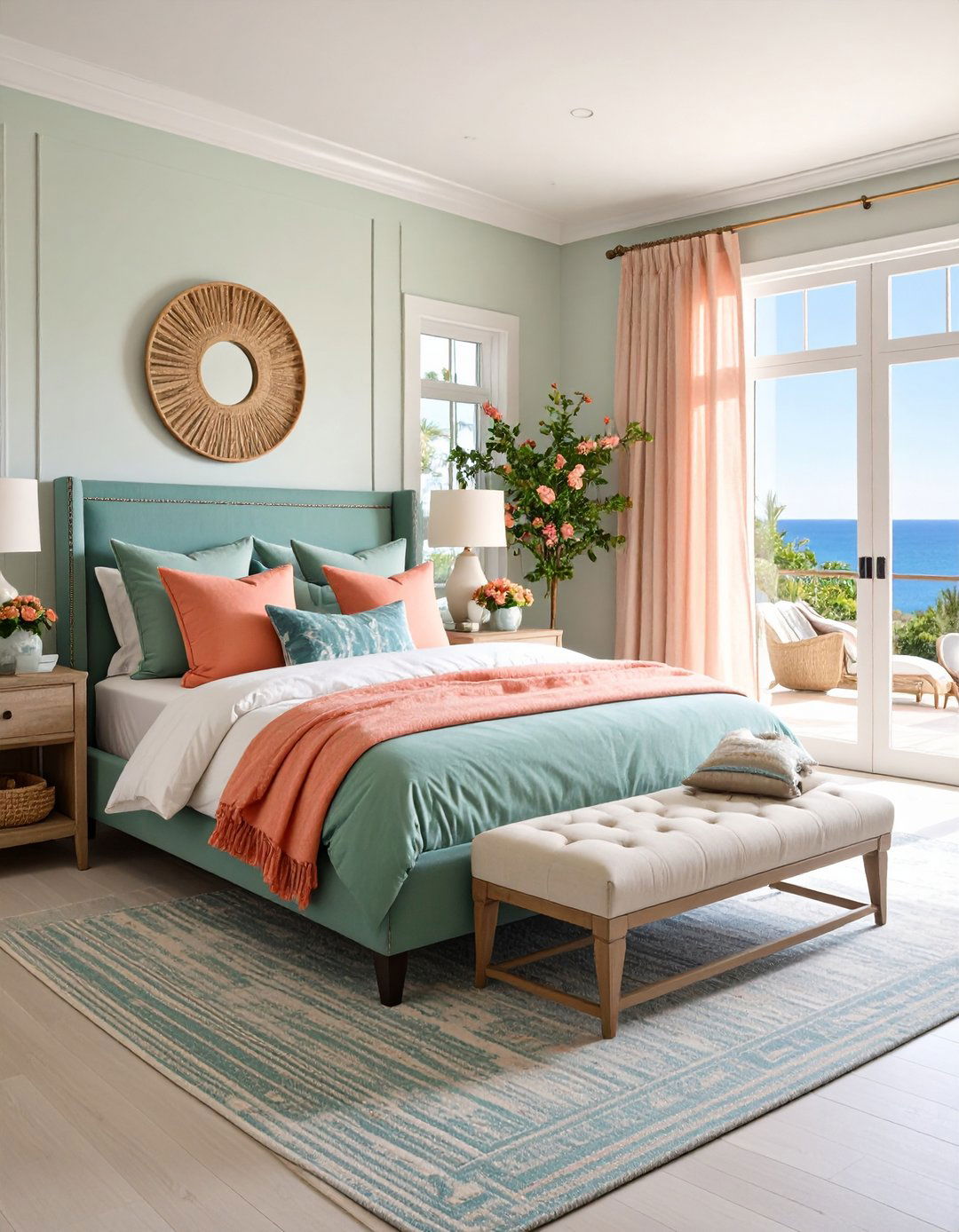
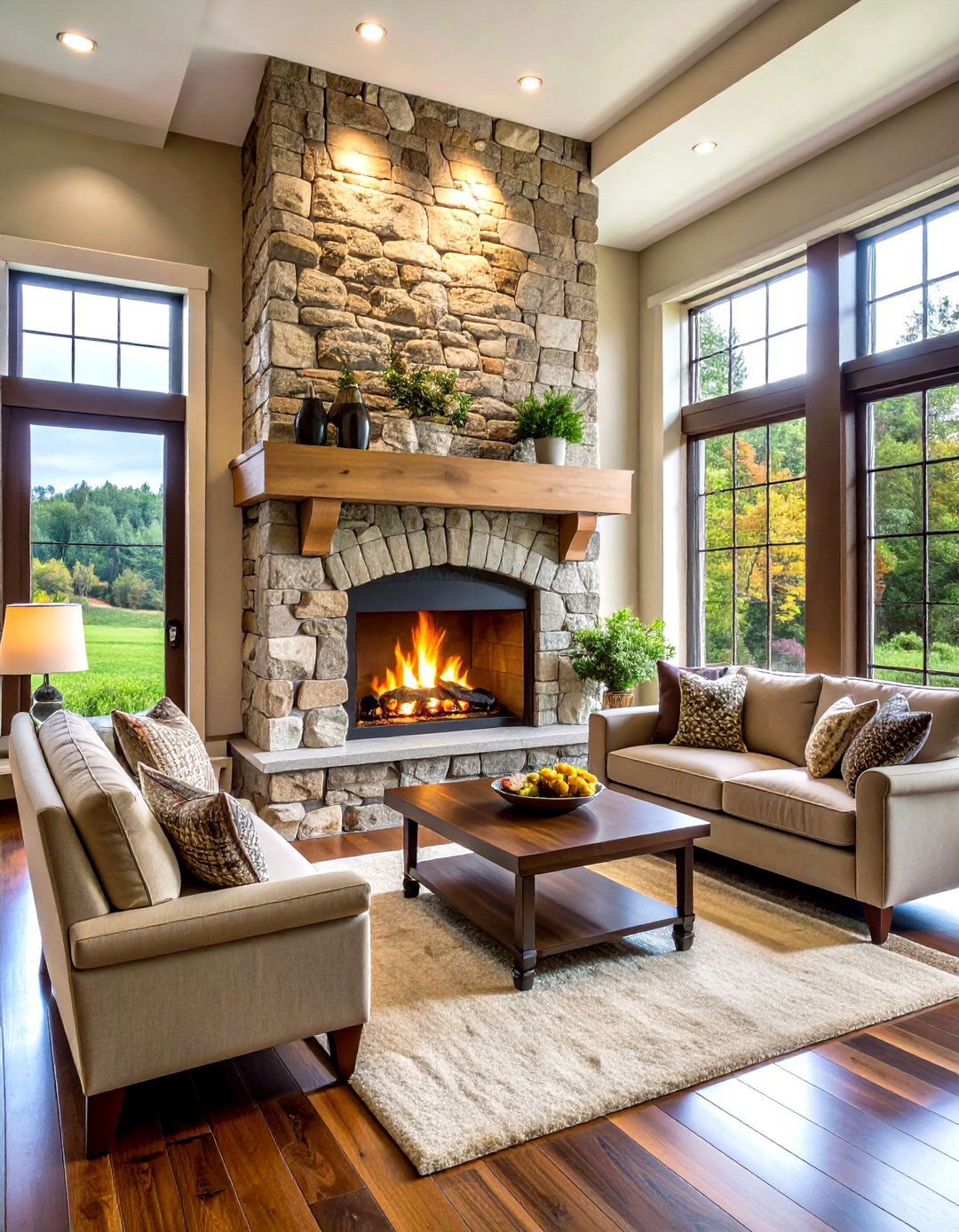
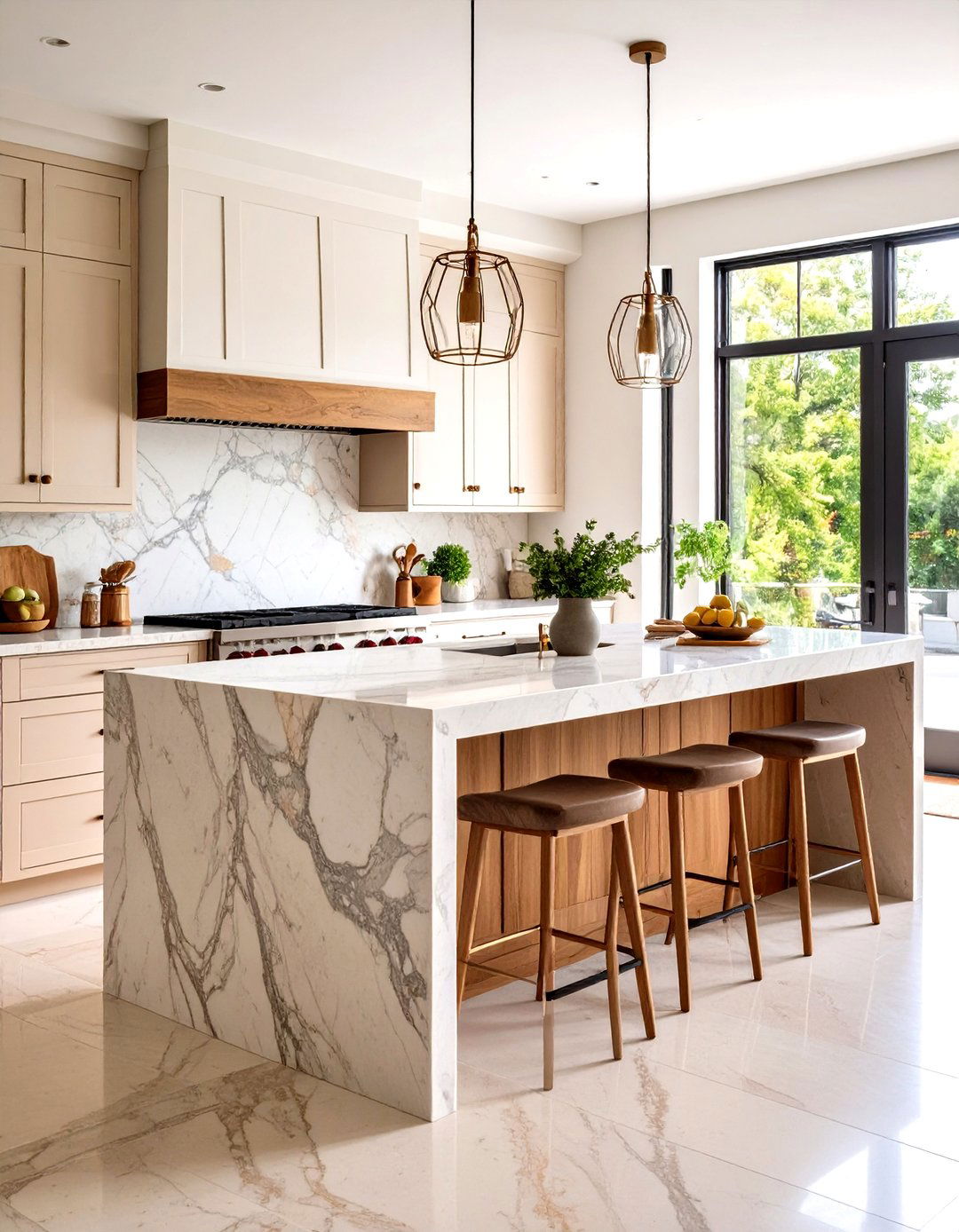

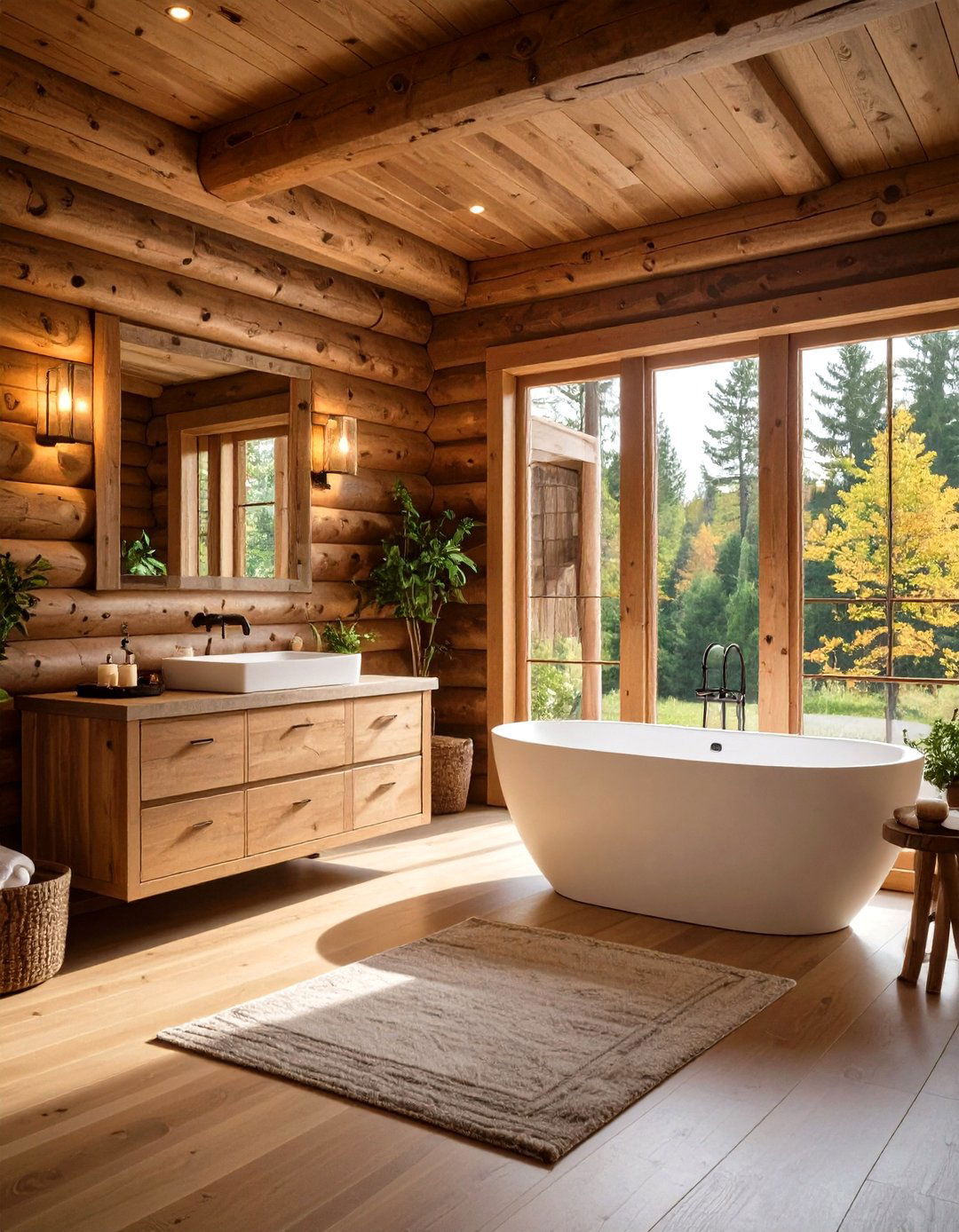
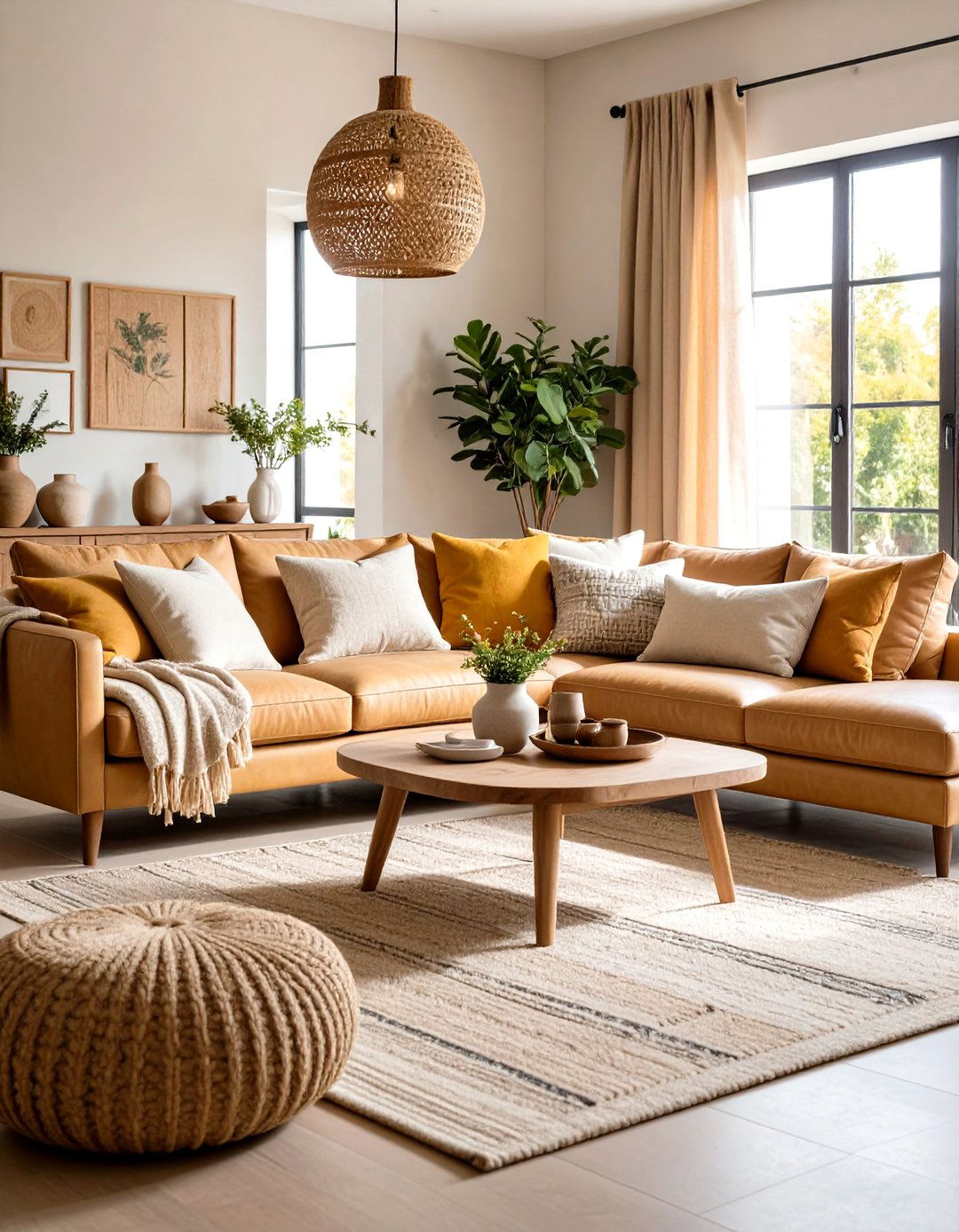
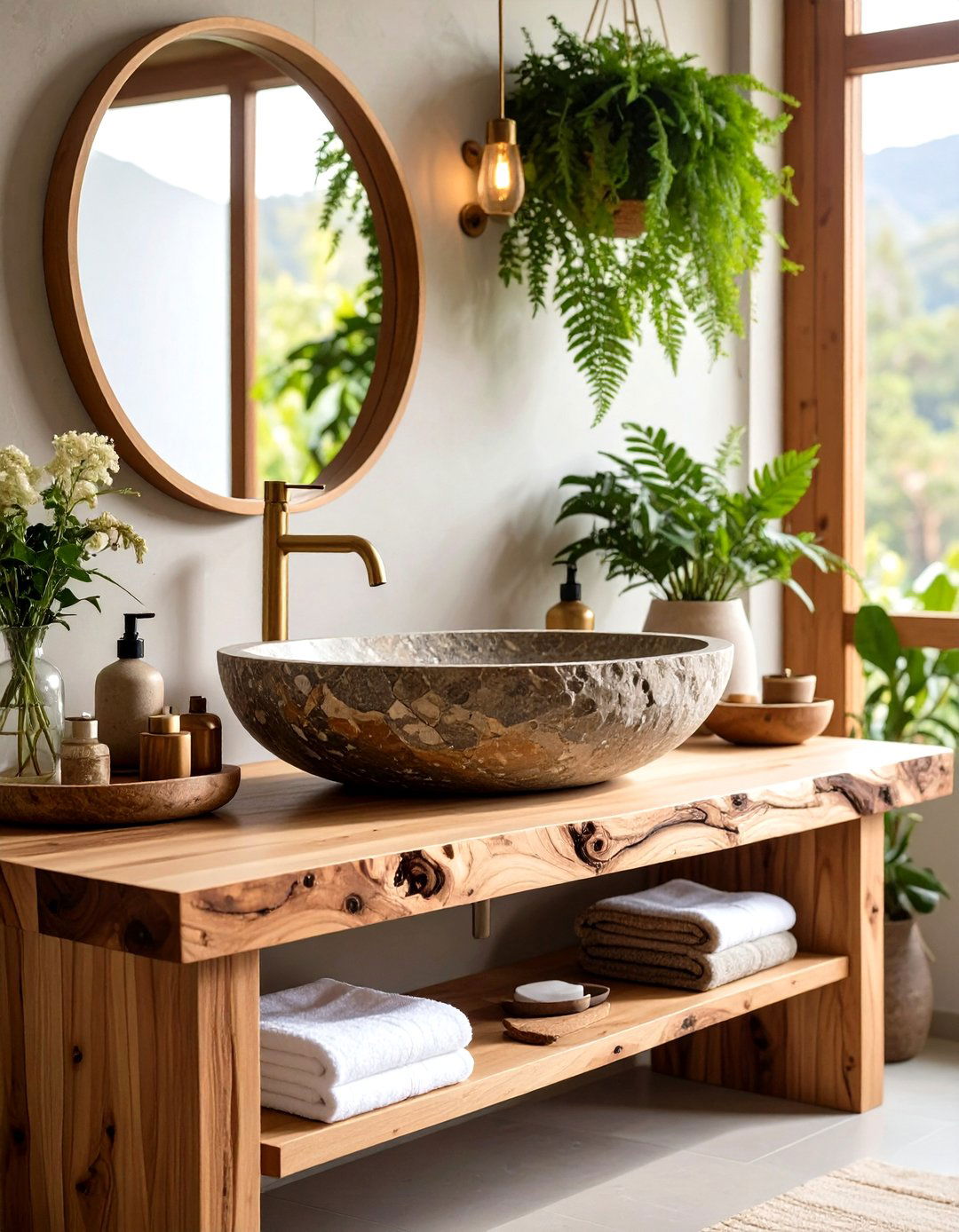
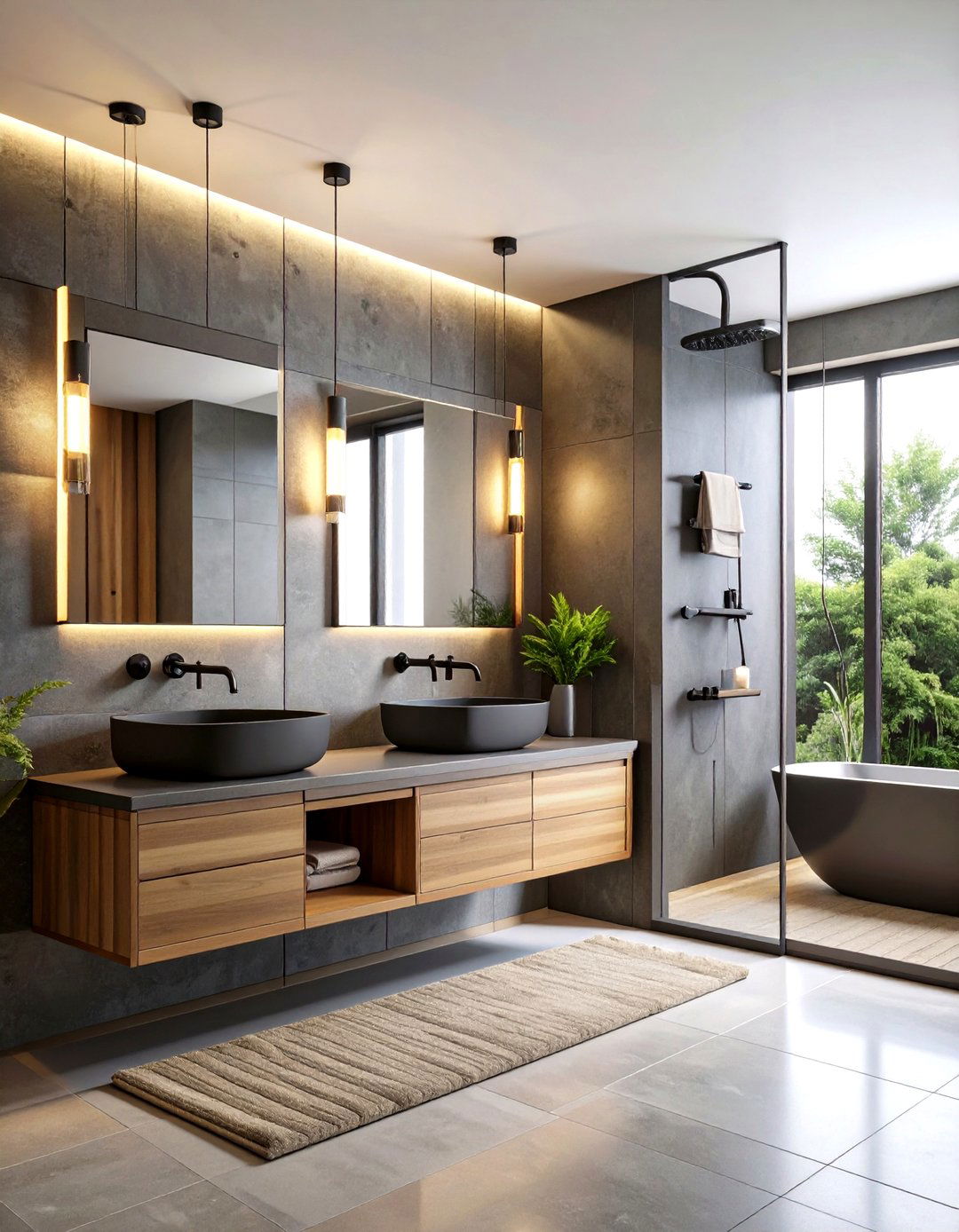

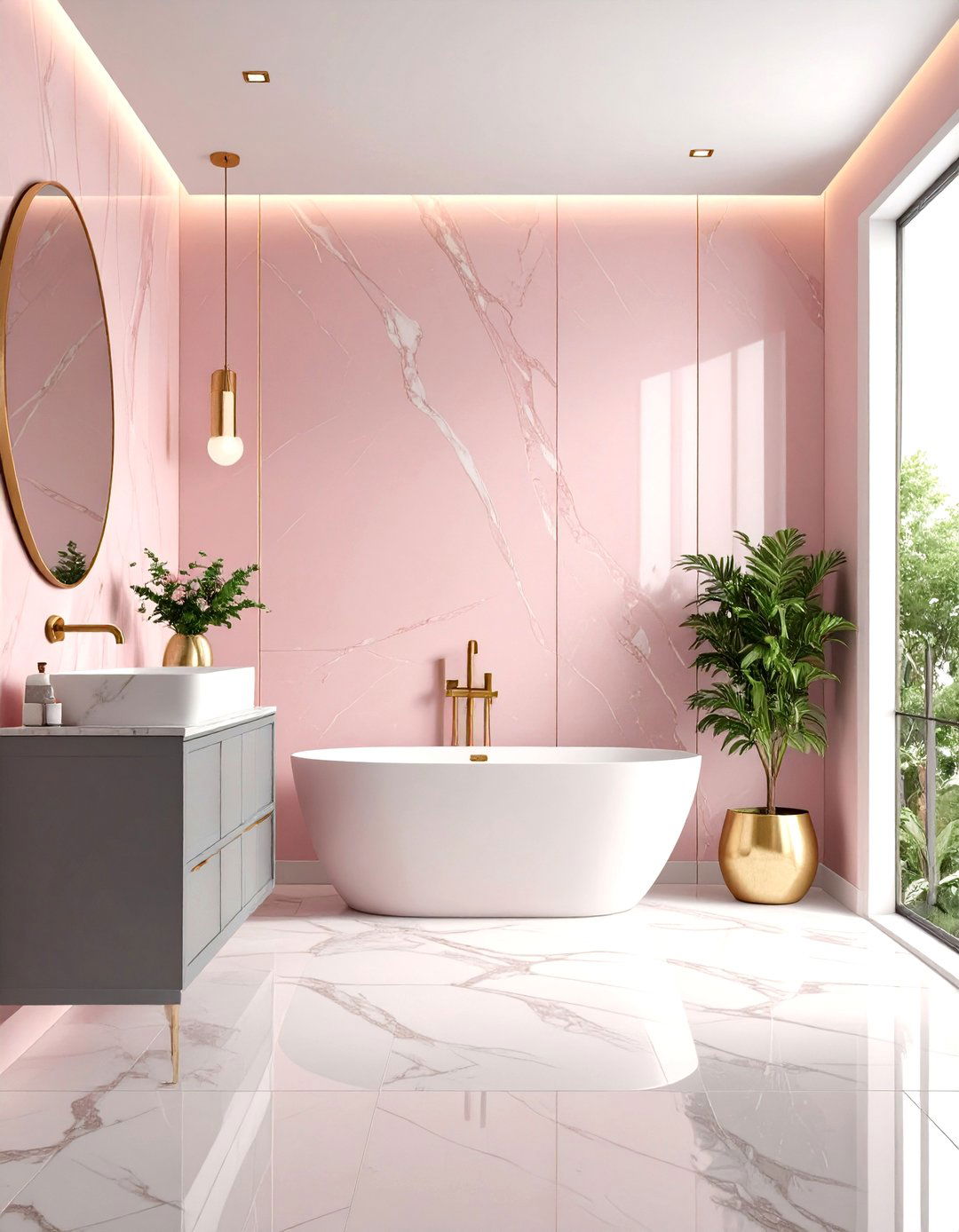
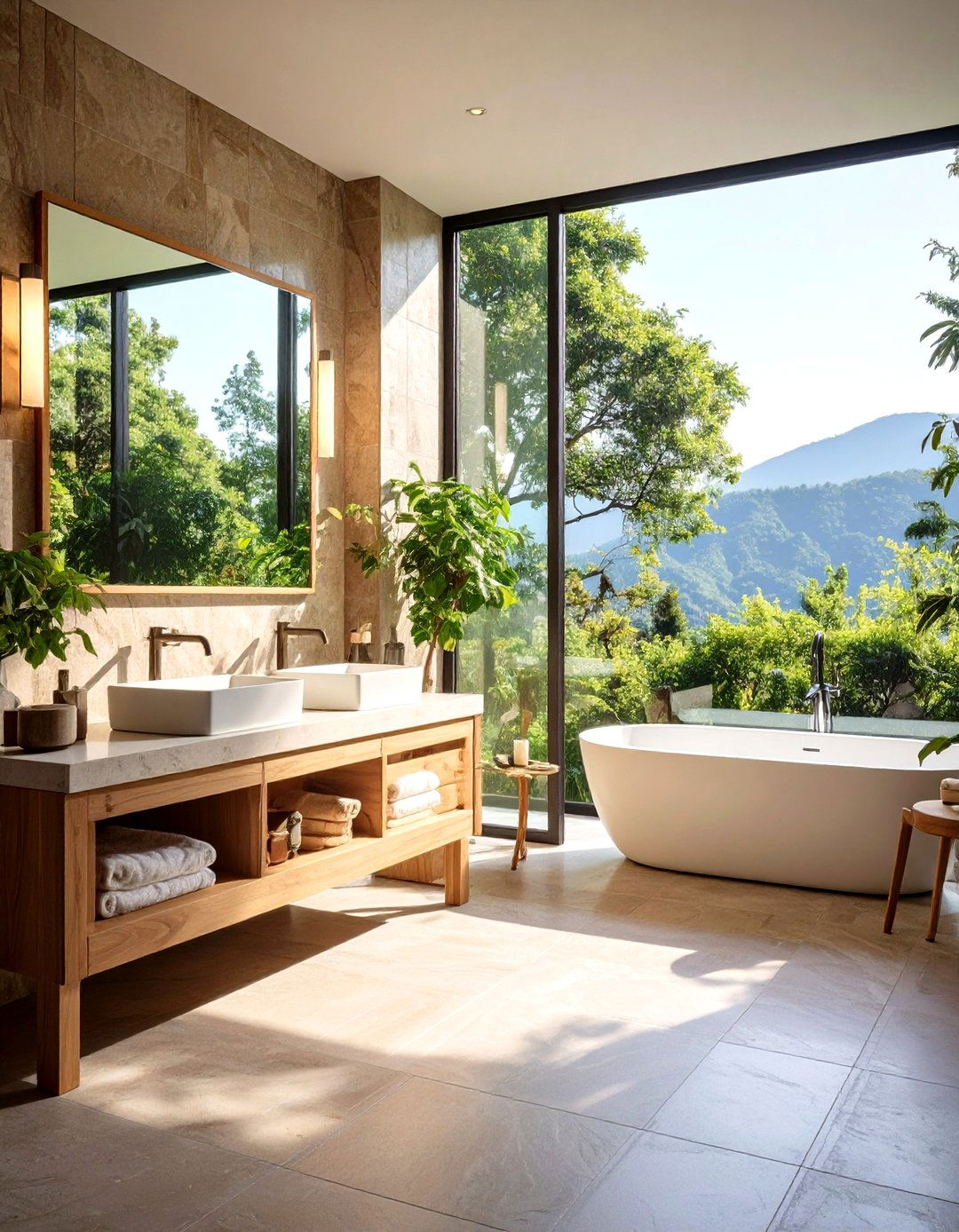
Leave a Reply